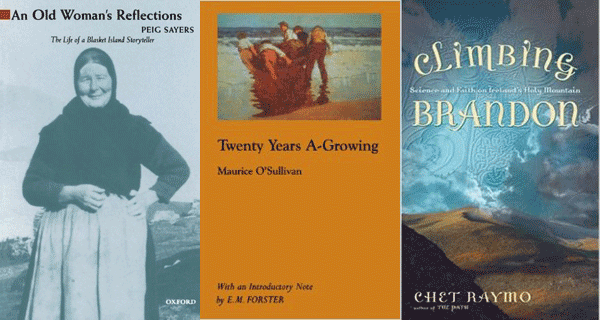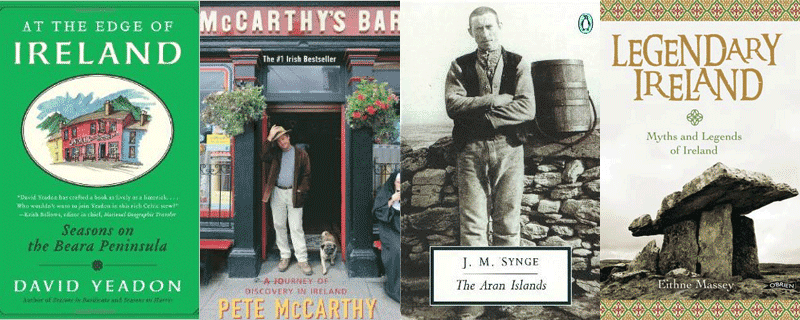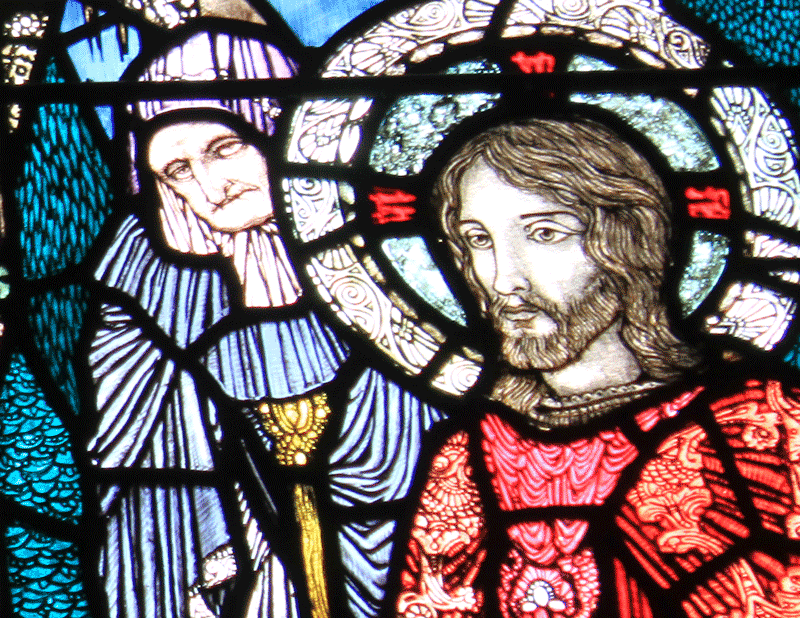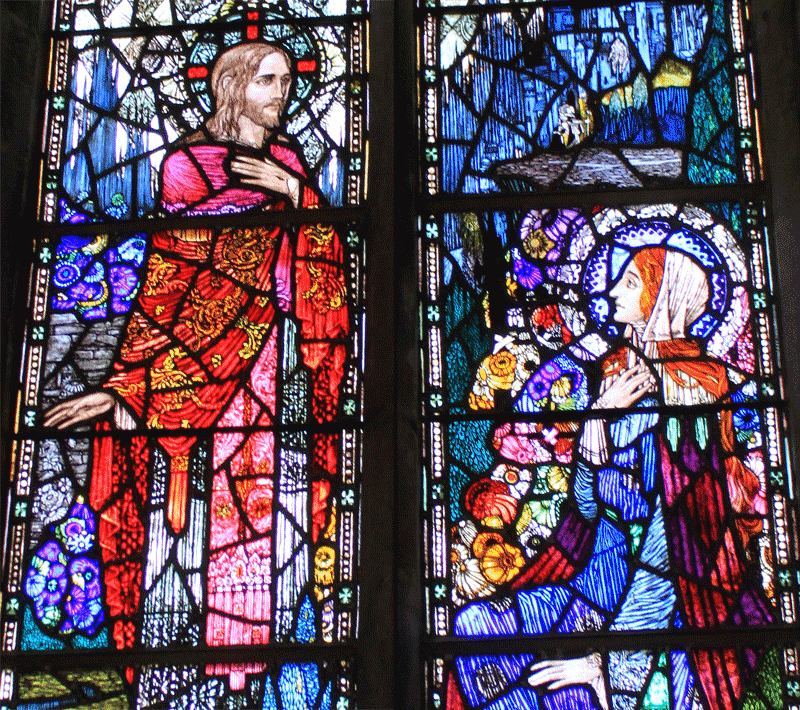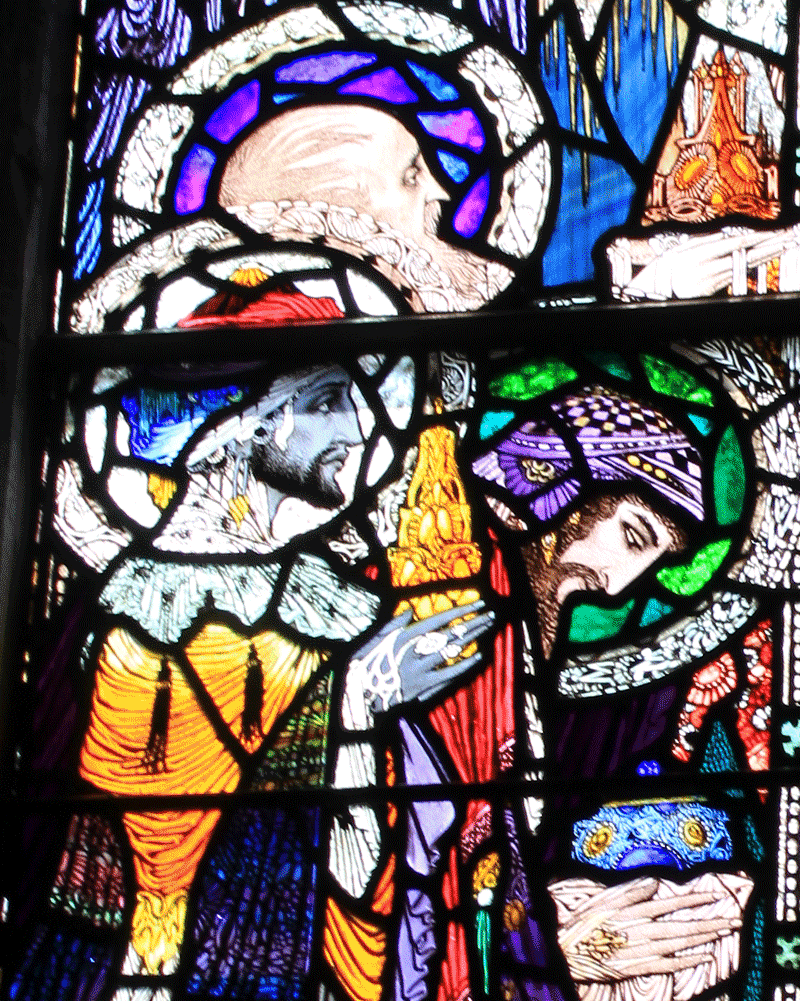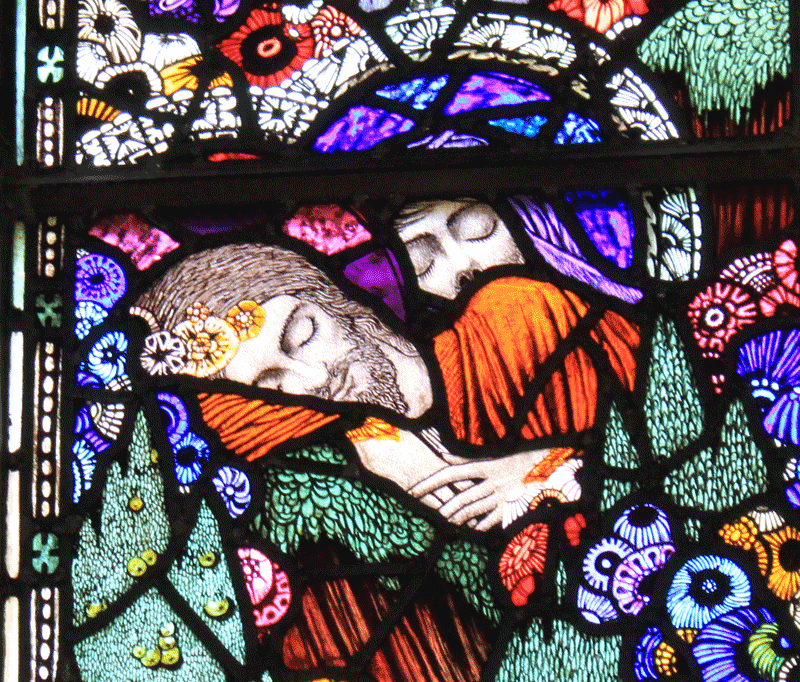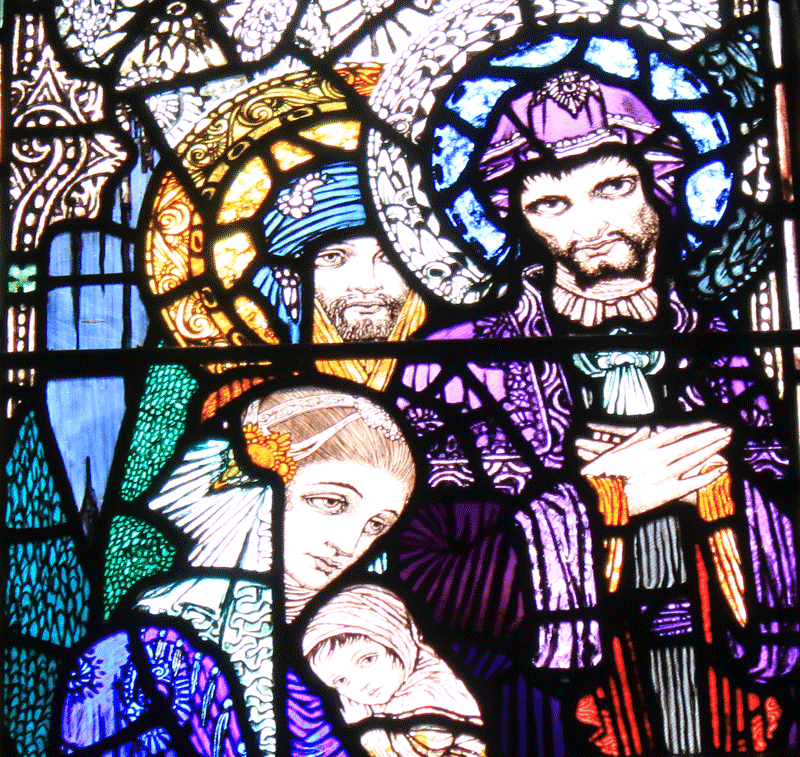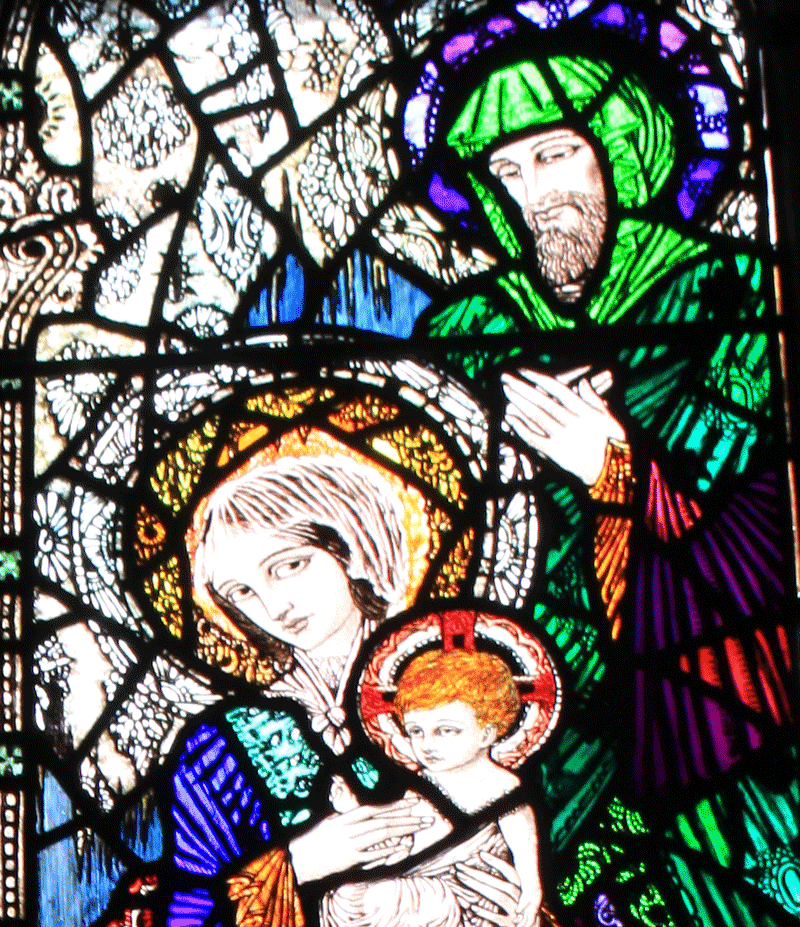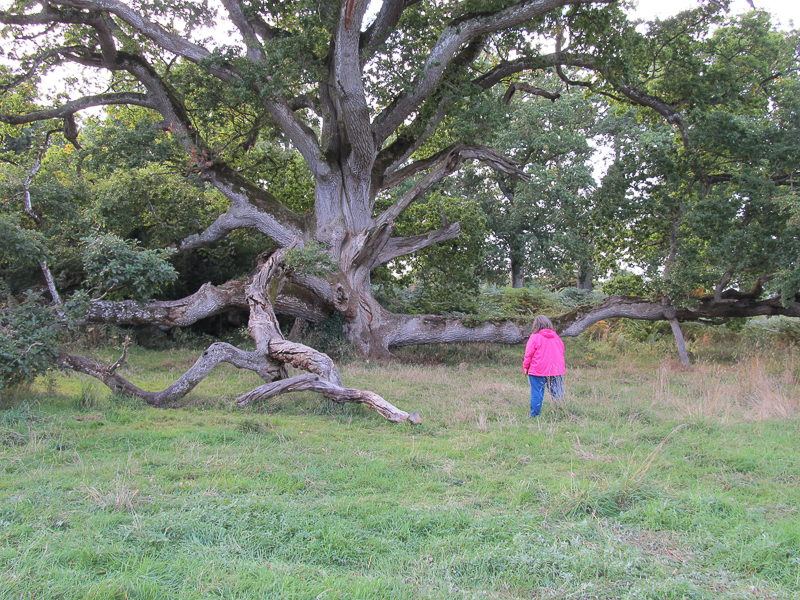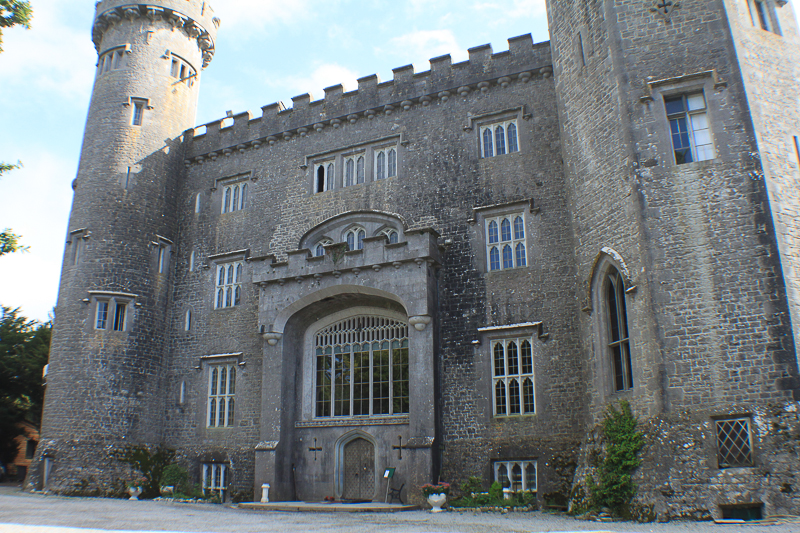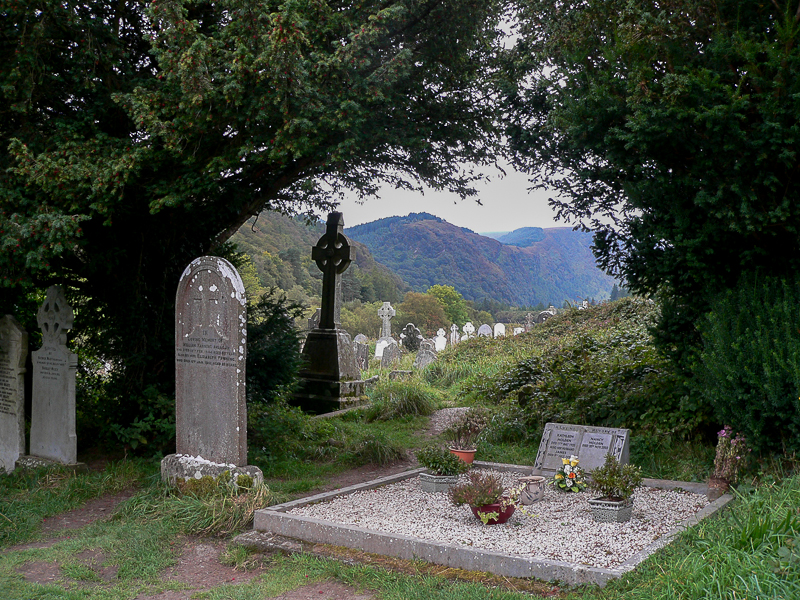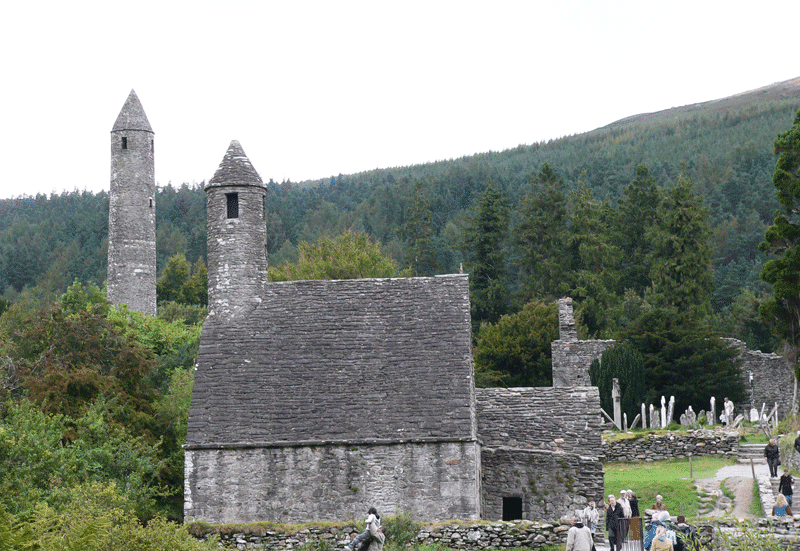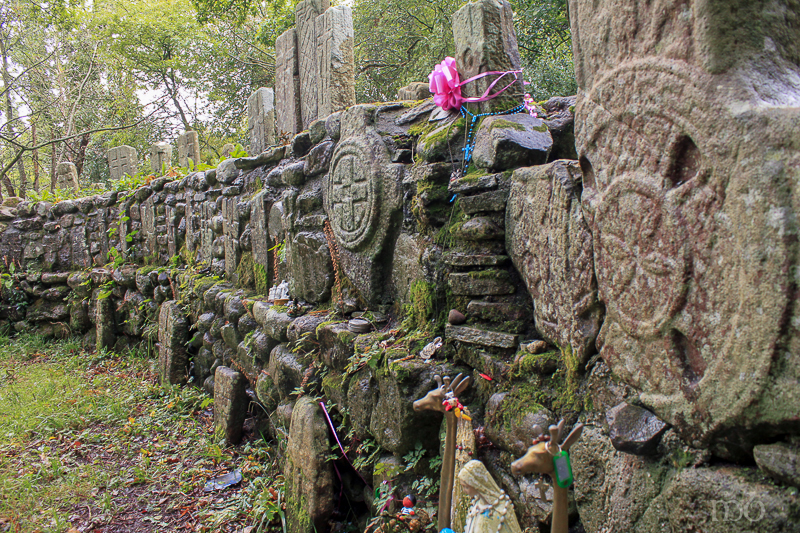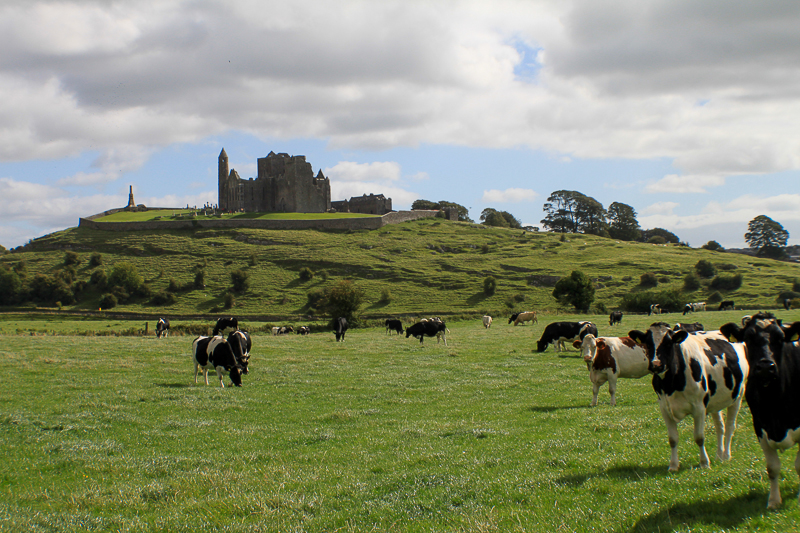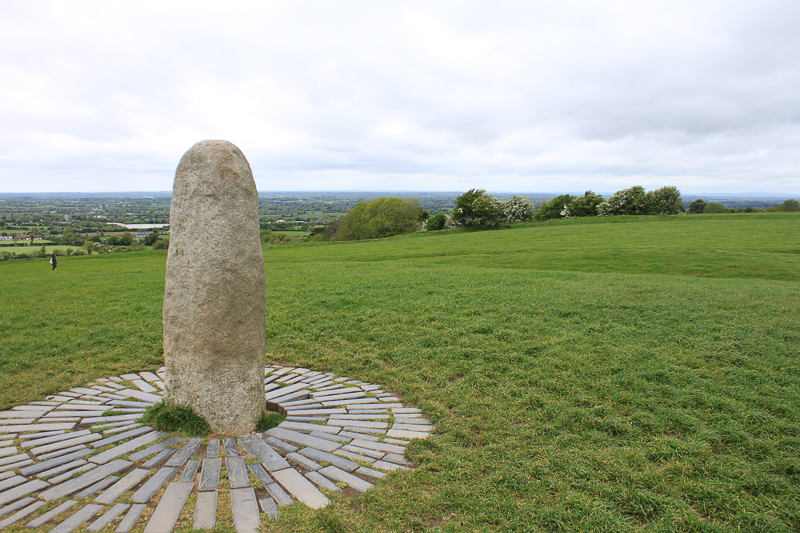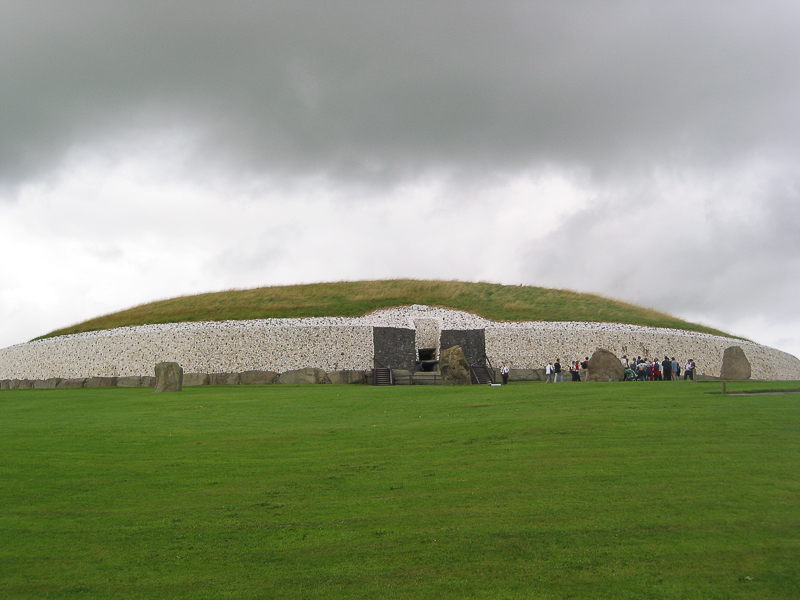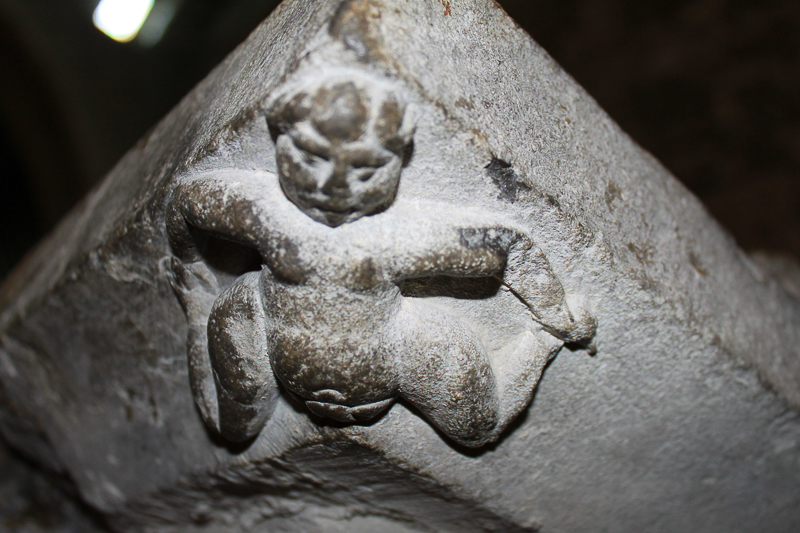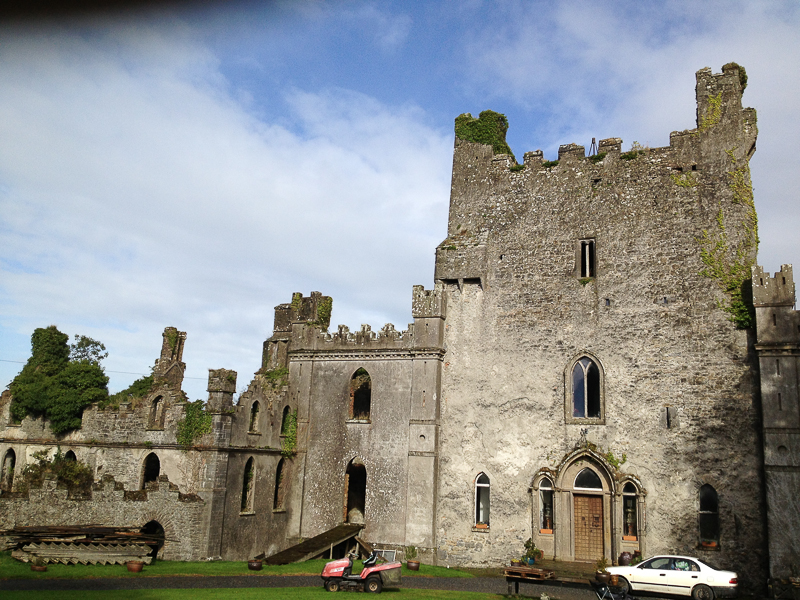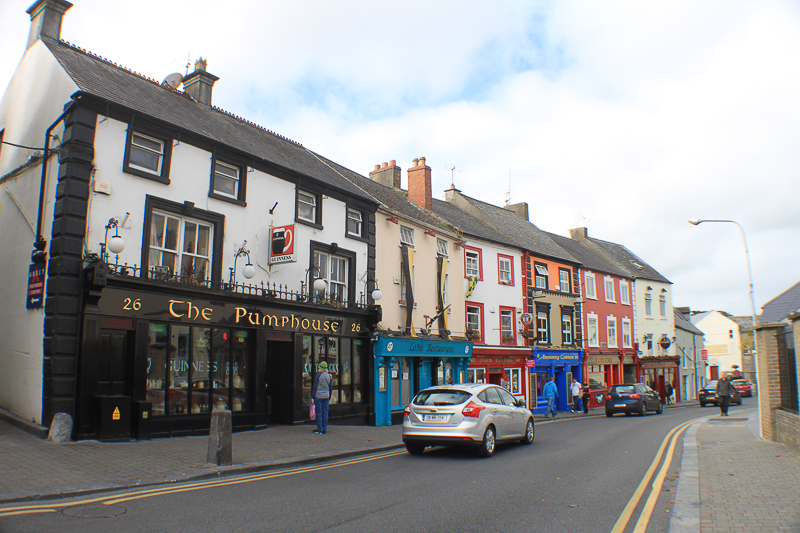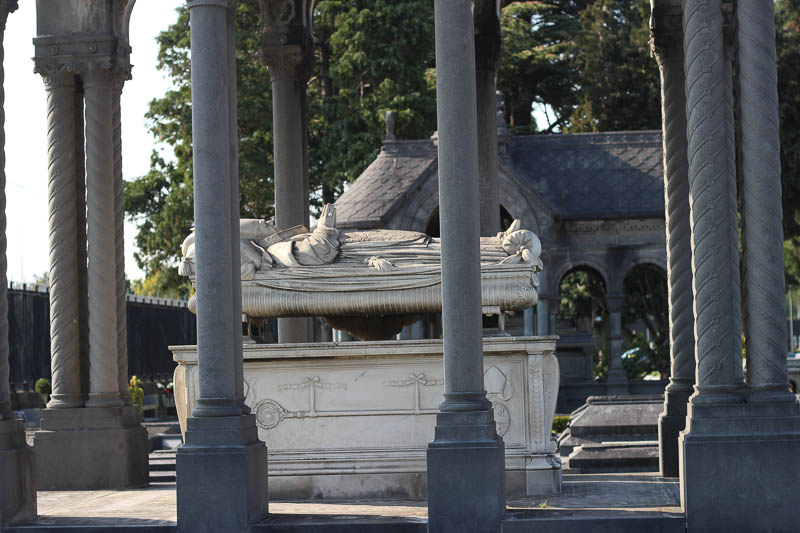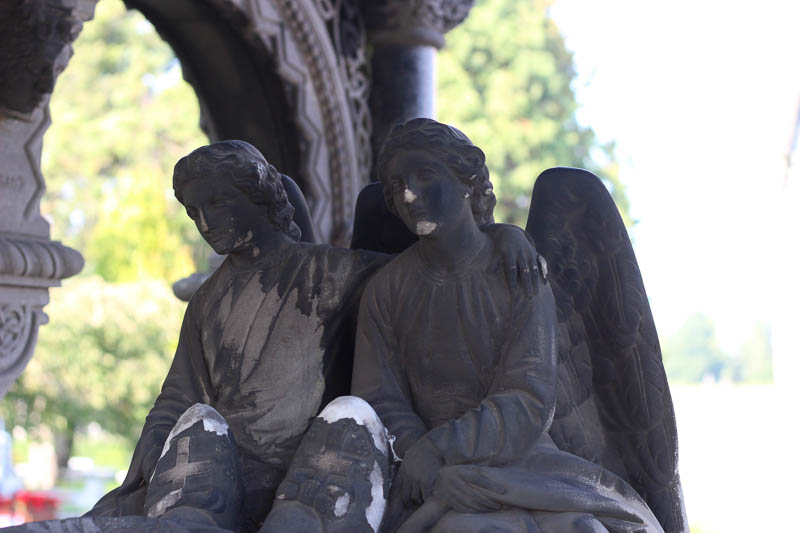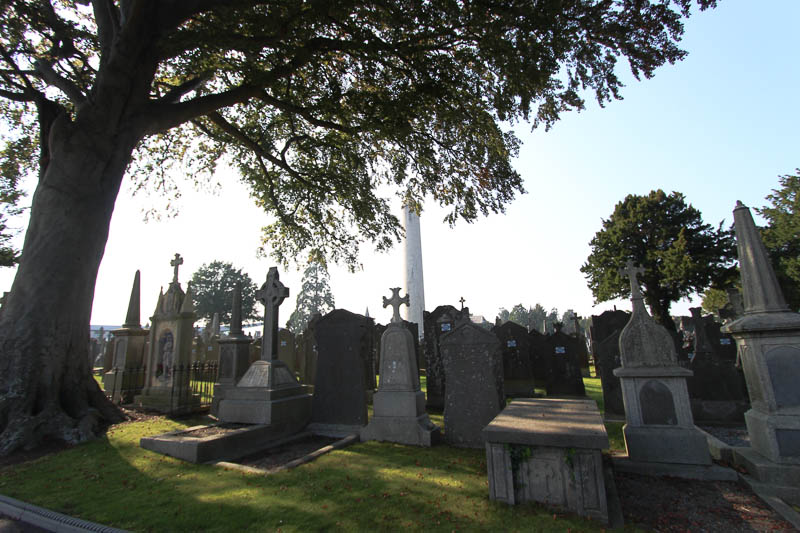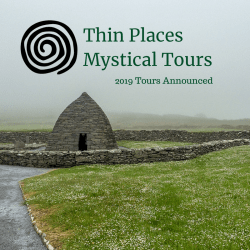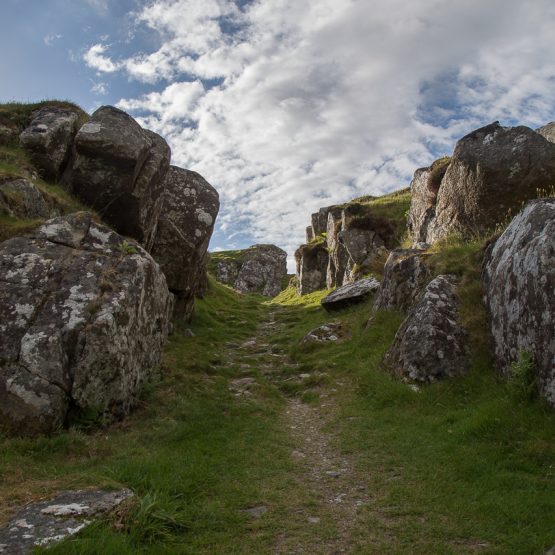Happy Candlemas – St Brigid’s Celebration
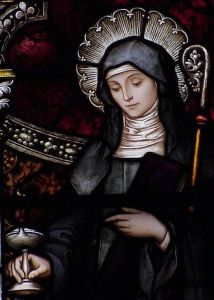
Happy Candlemas!
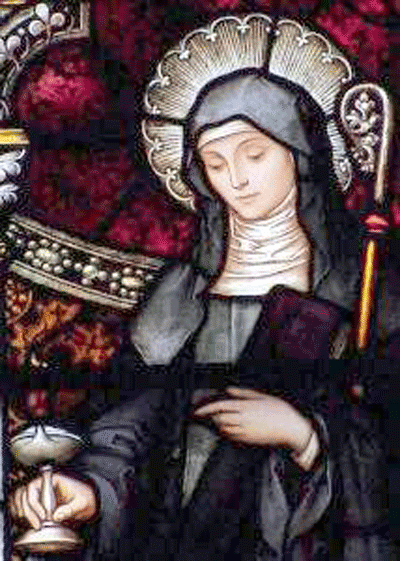
St. Brigid stained glass window
February 2nd – 02/02 – The feast of the flames – the bringing of the light.
This is also the Christian feast of the Presentation of the Lord Jesus in the Temple – the 40th day of the Christmas season.
So many cultures mark this day as a day to think of spring, of the thawing of the earth, the ending of the darkness, the long nights, the coming of the light. We think of St. Brigid of Kildare – Brigid the saint who brought the light of the Word, bread for the poor, peace to the troubled and welcome to the stranger whose feast day – February 1st is part of the “light” celebration.
Tree of the Day series
This is also the day I start a “Tree of the Day series” where I will post images of trees in thin places I have visit. These are special trees – fairy trees, healing trees, trees of mystery, trees associated with stories.
The Tobar Bhride Tree – Kildare
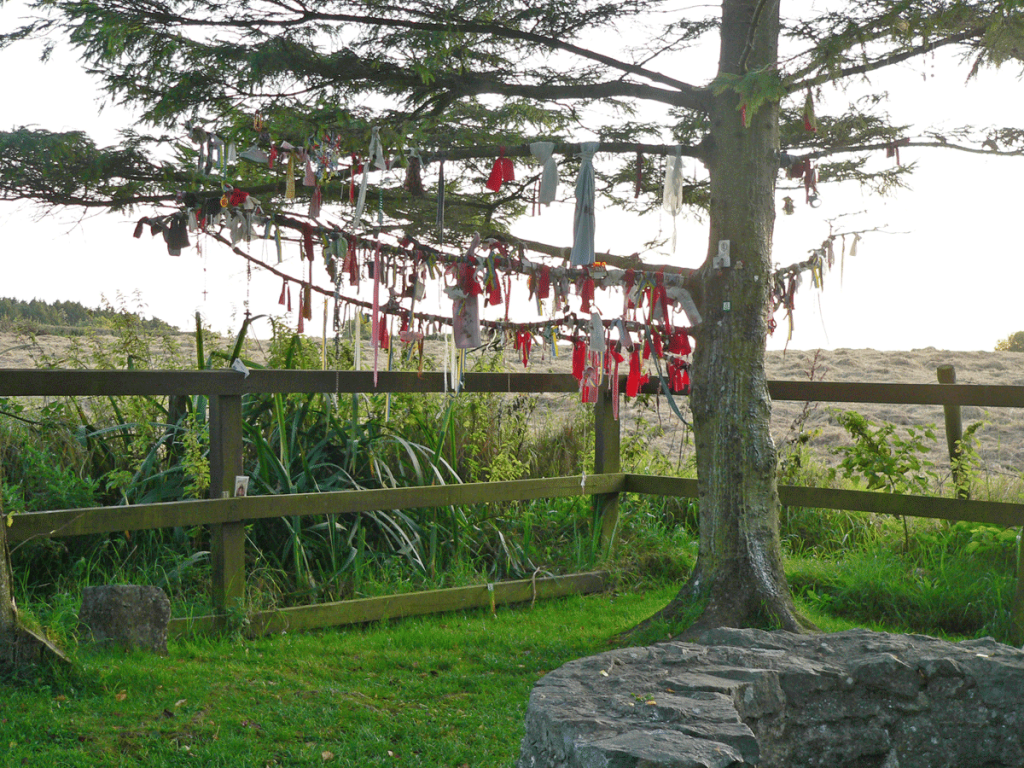
The tree at Tobar Bhride – Kildare
Today I’ll give you the tree at Tobar Bhride (Brigid’s Well) in Kildare. Local people and pilgrims from all over the world visit this well and the tree beside it bringing their prayers of devotion, special intentions and hearts full of thanksgiving for prayers answered.
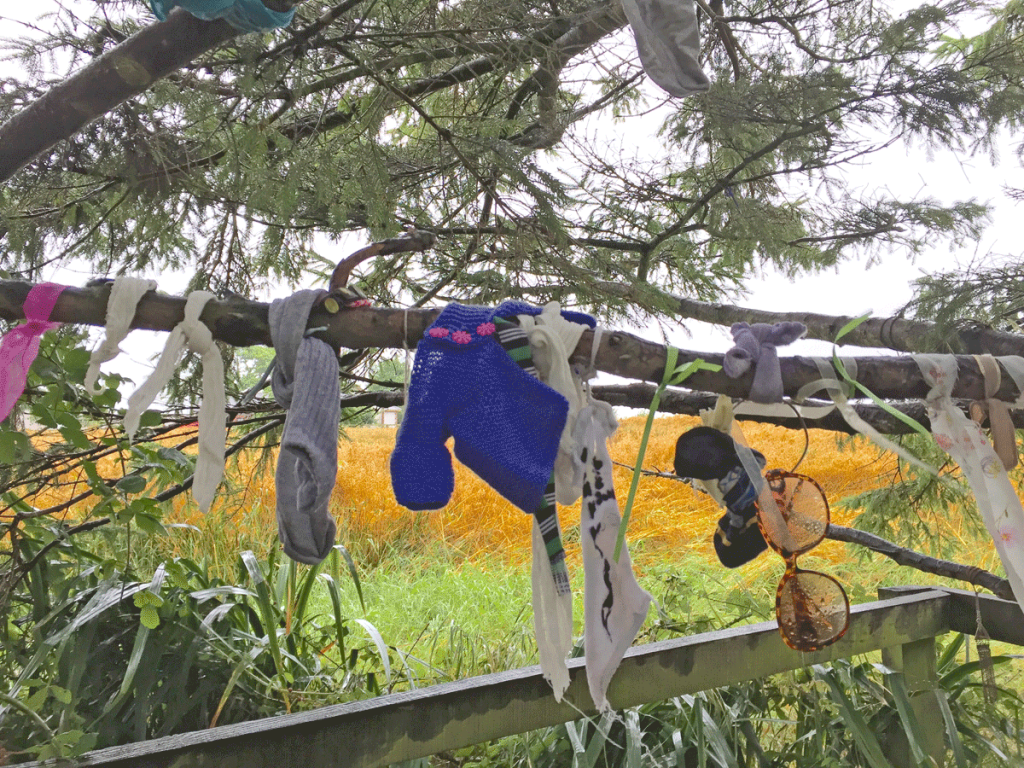
Tokens – “clooties” left on the branches.
As a sign of devotion, the faithful who visit the well sometimes leave a physical reminder of their prayer behind by tying a rag to the tree beside the well. Sometimes they leave something else of meaning behind – a possession of the person for whom they are praying, a photo, a prayer card. These tokens are called “clooties” and the lower branches of the Tobar Bhride tree is covered with them. Some of the clooties pull at the heart of the observer. .. pictures of sick mother, baby shoes, hair ties, little toys.
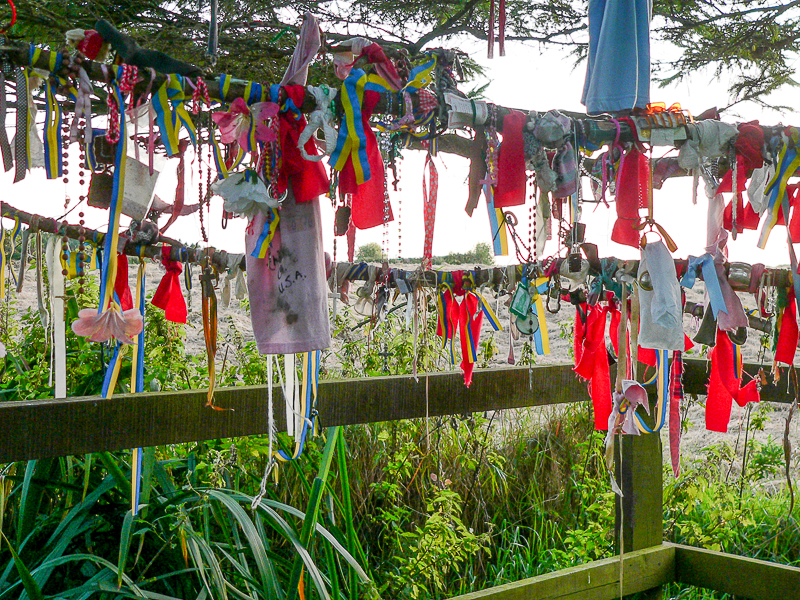
Clooties at Tobar Bhride Kildare
The local people who care for the well and its garden remove the clooties regularly to make way for more. According to the locals, the clooties are buried nearby. One cannot stand by the Tobar Bhride tree and not be moved. It has a quiet but powerful energy.
This tree, the holy well and the Solas Bhride center are a stop on the Discover the North, Castles & Saints and Trail of the Hag tours.
The Man in the Sand in the Shadow of Mount Brandon
A Man in the Sand Appears on the Beach near Mount Brandon in Dingle
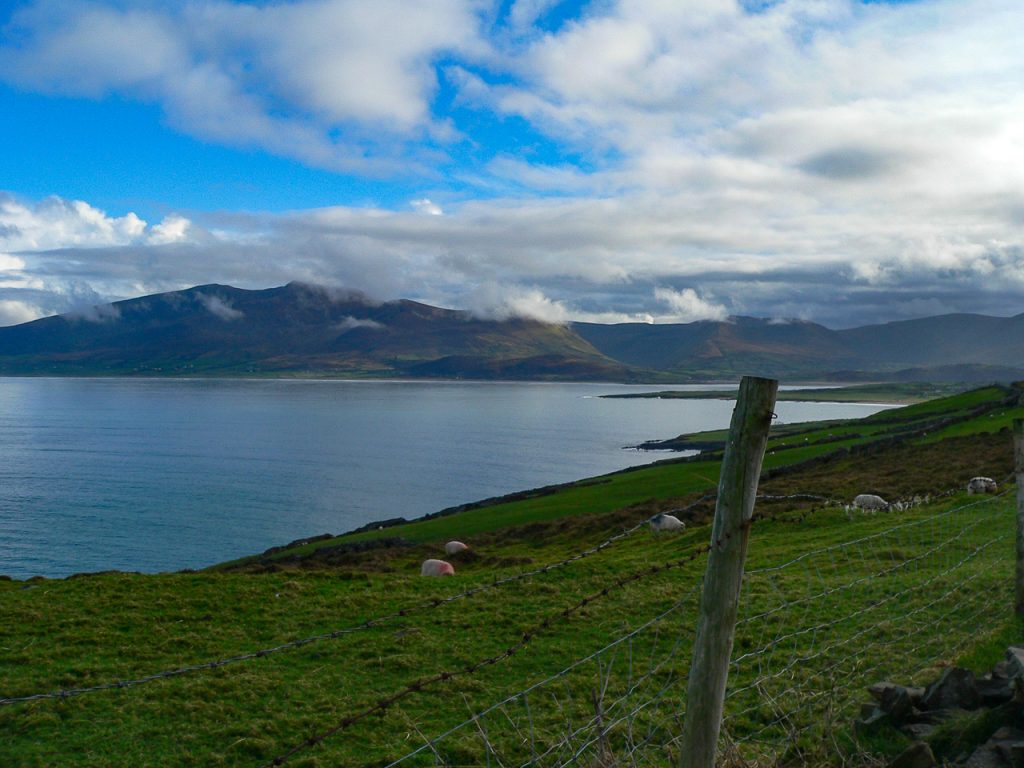
On a dreary February day many years ago, I was traveling alone in Ireland, doing some research for some writing I had to do on thin places in Ireland. Most of this day was spent on St. Brendan the Navigator who was born near Dingle and is a local heroic figure. I visited Ardfert, his first monastery, then Mount Brandon – the holy mountain named for him.
I was in a bad place personally when I wrote this travel journal entry. I’d been working on completing this book for years and I couldn’t move myself forward. No amount of research could push me to completion. Every time I started, I stopped. I had no confidence – filled with self doubt.
This was also a day of miracles – or coincidences. There’s something different about praying in a thin place, though. If you listen hard enough, sometimes you hear an answer or get a sign. This a day for one of those knock-you-in-the-head burning bush signs.
Travel Journal entry – February 20, 2009 – Ireland, Co. Kerry
Mount Brandon – coming from the north road into Dingle after passing the exits for Castlegregory, I came to Fermoyle strand. Mount Brandon dominates the landscape on all the north roads.
Mount Brandon is the second tallest mountain in Ireland and at its base, St. Brendan the Navigator is said to have launched his fleet of curraghs to set sail for the Promised Land as revealed to him in a vision. Prior to the voyage, he spent time on this holy mountain-top in reflection and prayer similar to St. Patrick’s retreat on Croagh Patrick. Also similar to Croagh Patrick, it’s likely that both holy mountains were considered sacred by the local people long before Christianity came to Ireland.
To say the scenery here is breathtaking would understate. It’s magical. The dismal sky and drizzle offered a blue-gray backdrop, but allowed just enough sunlight to illuminate the vivid green fields dotted by sheep at the base of the mountain. Down on the strand the wet sand at the shore is firm – almost like slate. The waves rush in and then Atlantic sucks the surf back out almost a half a mile – leaving various shapes in the flat sand. I was the only one on the strand. The only human image in that landscape.
I pulled into a little car park for people walking out to the beach. It started to rain buckets. So I sat in the car for awhile reading over notes and other authors’ writing about thin places in Ireland. I opened up an article by a well-known author – one whose work had appeared on the New York Times Best Seller list. Though I loved this author’s works of short fiction, I was disappointed in how sappy and trite this piece on thin places was. The writer overtold the meaning. The work left me feeling the writer was trying more to project a sense of spiritual superiority than remark on the mystery of a thin place.
I’m so judgy.
I thought to myself, “how is it that this successful author can get stuff like this published about this places, and I can’t write a word?”
Rain stopped. I continued my indulgence in self-pity as I walked out onto the strand. The tide was out and the sand seemed to stretch on forever. Mount Brandon dominated the landscape. I noticed a pale light hanging it illuminating a very low, wispy cloud just touching the peak. I was then then I stepped into the moment – feeling no passing of time… just being.
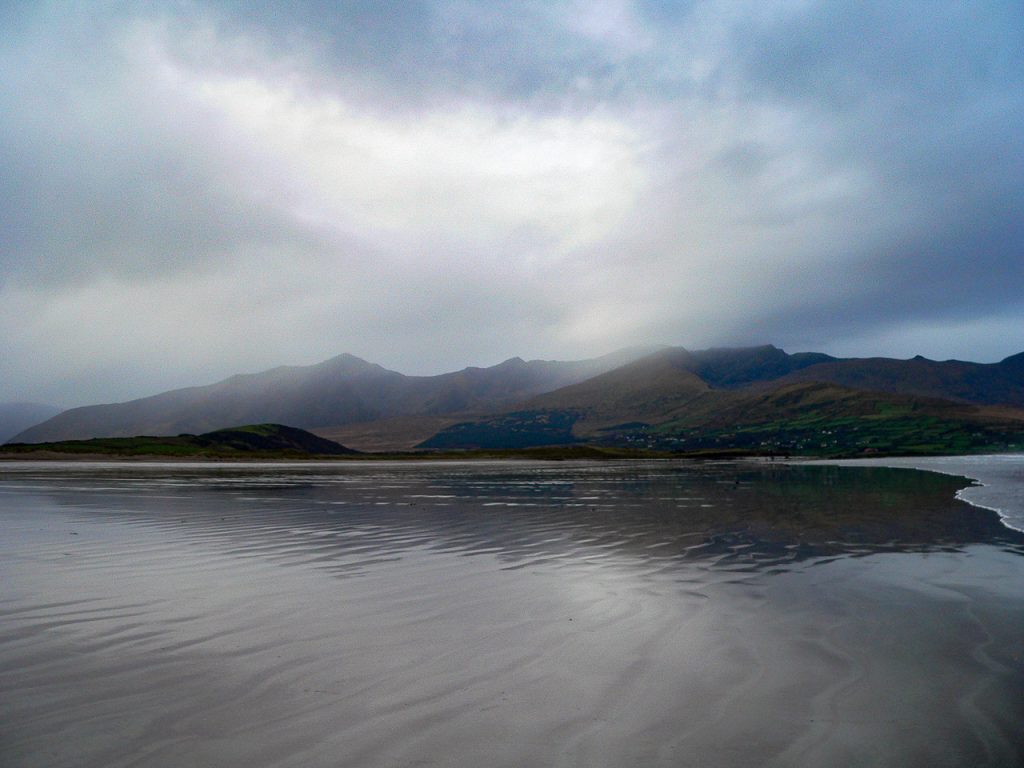
With a great sense of inadequacy, I turned to God, or whoever might be listening and said, “I can’t write. No matter how hard I try. I can’t write.”
My one-sided conversation was pretty anti-climactic. But then I looked down at the sand. There was an image created by the receding waves. It seemed to have a head, body, legs, and its right hand was extended with what looked like a flower or a box or something. It looked like a faceless man in a cloak. I thought, “Am I really seeing that? I’m just imagining that it looks like a man in the sand. But it didn’t wash away or fade away. So I started snapping pictures.
Even after fifteen minutes the man in the sand was just as clear as he was when I first noticed him. At times like this, I guess we try to find meaning. Was it a sign? Did it mean something? If so, what? I was reluctant to ascribe any meaning to the man, but it sure felt like …. something.
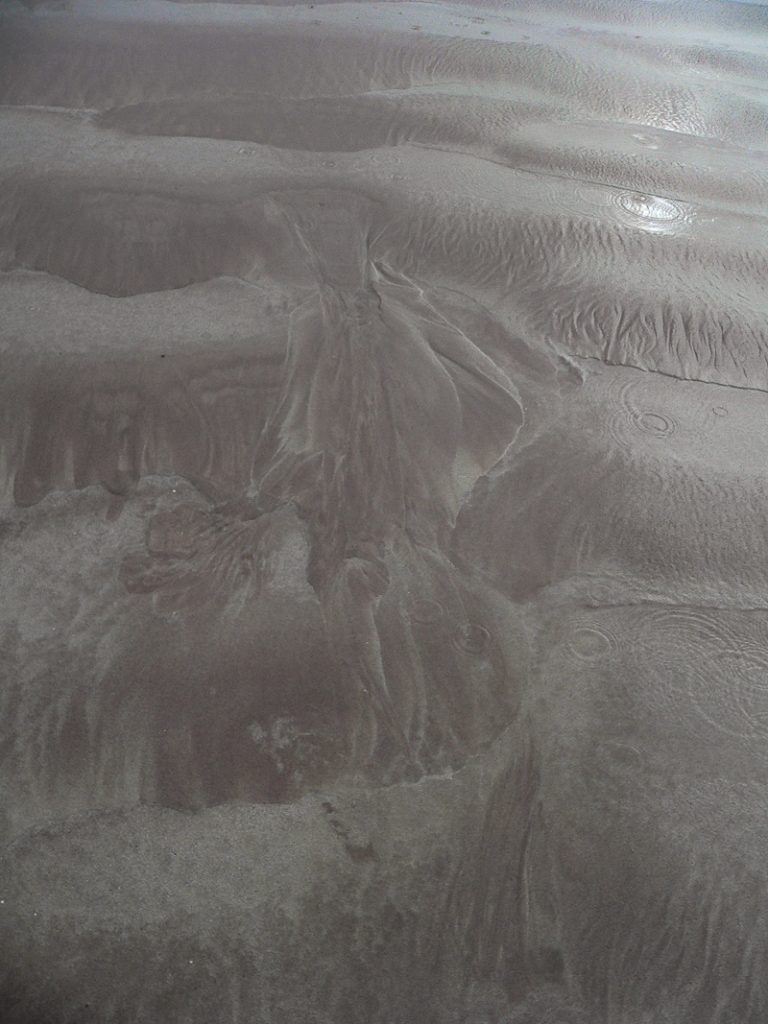
It was surely a synchronistic moment.
Caitlin and John Matthews remind us that we communicate with our five senses in the physical world, but we communicate with our spirit in the spirit world. They also give us insight on how to perceive coincidences moments of synchronicity – the simultaneous occurrence of events that appear significantly related but have no discernible causal connection. Here’s a quote referencing this from their book, Walkers Between the Worlds.
“… synchronicity… is actually an instance of an exact match between the fabric of our world and that of the Otherworld. While we normally dismiss such an occurrence as coincidental, in looking more deeply we can see the exact correspondences between one world and the other.”
After I was done with my man in the sand, I turned to leave. I was headed by car to the foot of Mount Brandon. There’s a road that winds around past Brandon village and ends at a place called Ballydavid north. It’s as far as you can go around Brandon Bay and the road ends at a little car park where one can take off up the mountain on foot. The rain was coming back and about to pour. The sky was black. As I turned to leave the beach I notice a bright ribbon of a rainbow in the eastern sky. Wow.
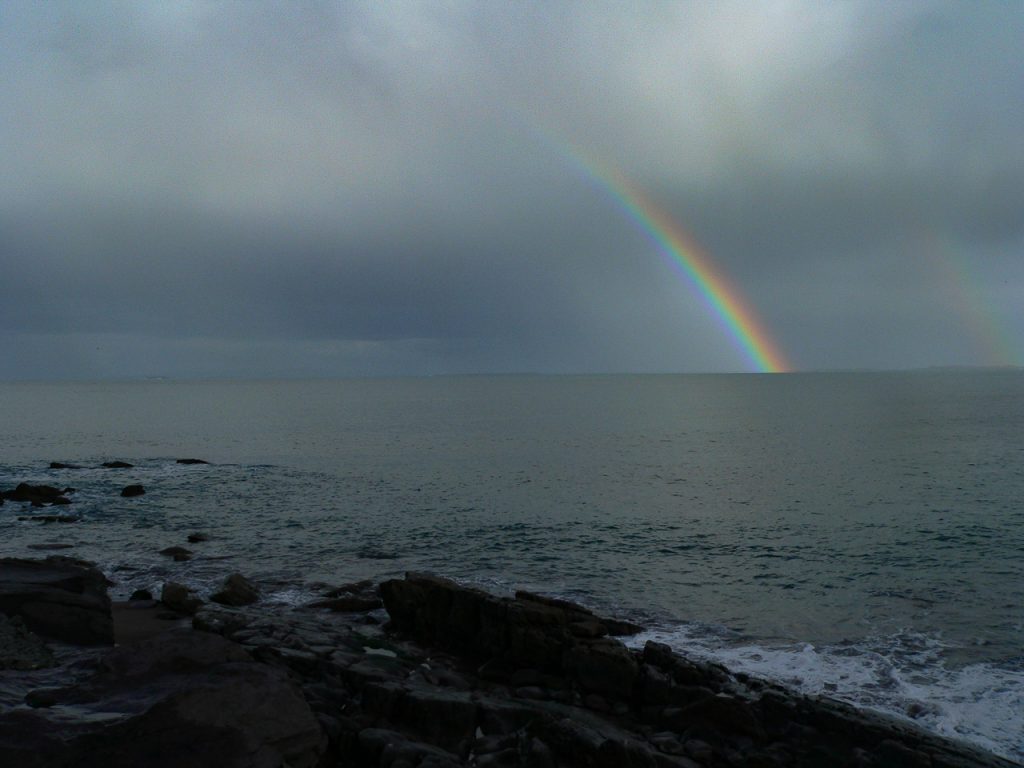
Another sign? Maybe. Maybe another coincidence.
I got to the car and headed out. For 20 minutes I drove and for 20 minutes that rainbow followed me. It was still there when I got to the foot of Mount Brandon. And I stayed there another twenty minutes as the rain fell and the sky cleared … watching it fade away. What a day.
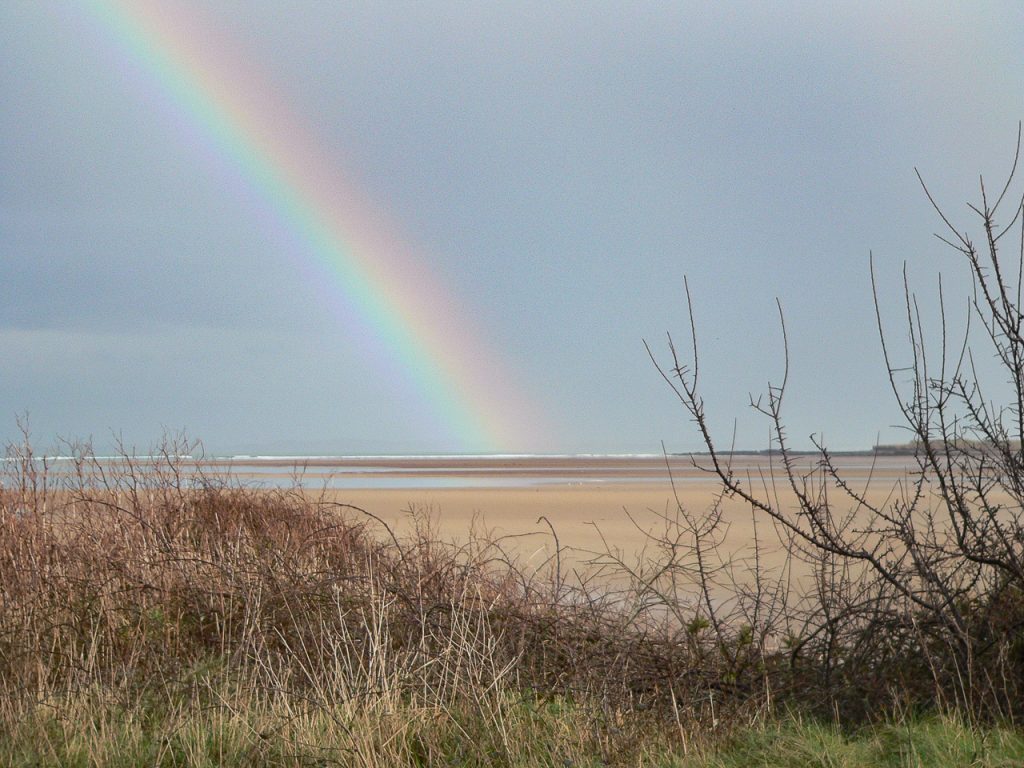
The eternal world or spirit world or Otherworld is one side of reality while our physical world is the other. But together they show us one world, one reality. A thin place brings us face to face with these two sides of one reality, and our prayers – our conversations with the Creator are whole and enjoy a sense of completeness.
Fermoyle Strand and Mount Brandon are thin places. At the time I was experiencing the above-mentioned synchronicity in Dingle I didn’t understand what any of it meant. Thus the importance of journaling and taking photo images. As we grow in spirit, so does our understanding.
And when I got home … I couldn’t stop writing. I’m still writing.
Faces in the Rock – Glenariff Woodland
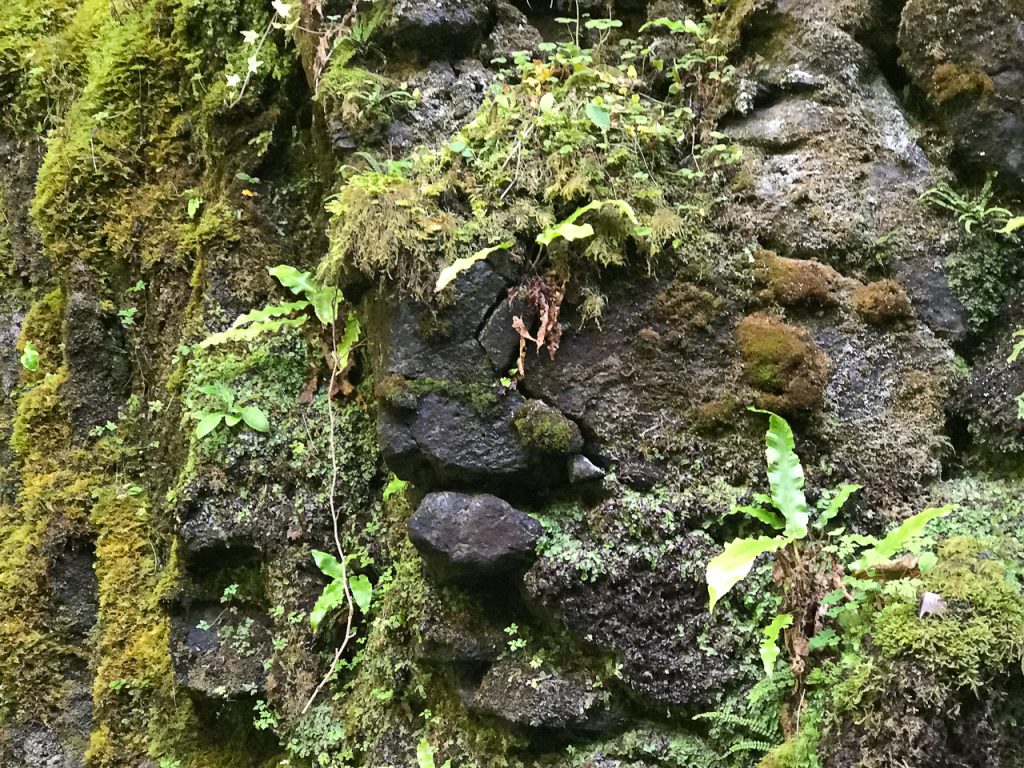 Forests and Woodlands tend to scare us. If they don’t evoke fear they at least elevate our senses. The edge is defined. We feel it as soon as we cross from the open world into a woodland. The energy shifts – changes.
Forests and Woodlands tend to scare us. If they don’t evoke fear they at least elevate our senses. The edge is defined. We feel it as soon as we cross from the open world into a woodland. The energy shifts – changes.
My friend, Wendy Mews leads tours to sacred sites in Brittany. Wendy led me through a forest near her home in Huelgoat and talked about “walking meditation.” She said that she will tell her tour guests to walk in the forest as a group – but in total silence. And she instructs her guests to notice details in that silence, to be mindful of what the forest tells them. “What do you hear in your heart? What do you feel? What does the forest tell you?”
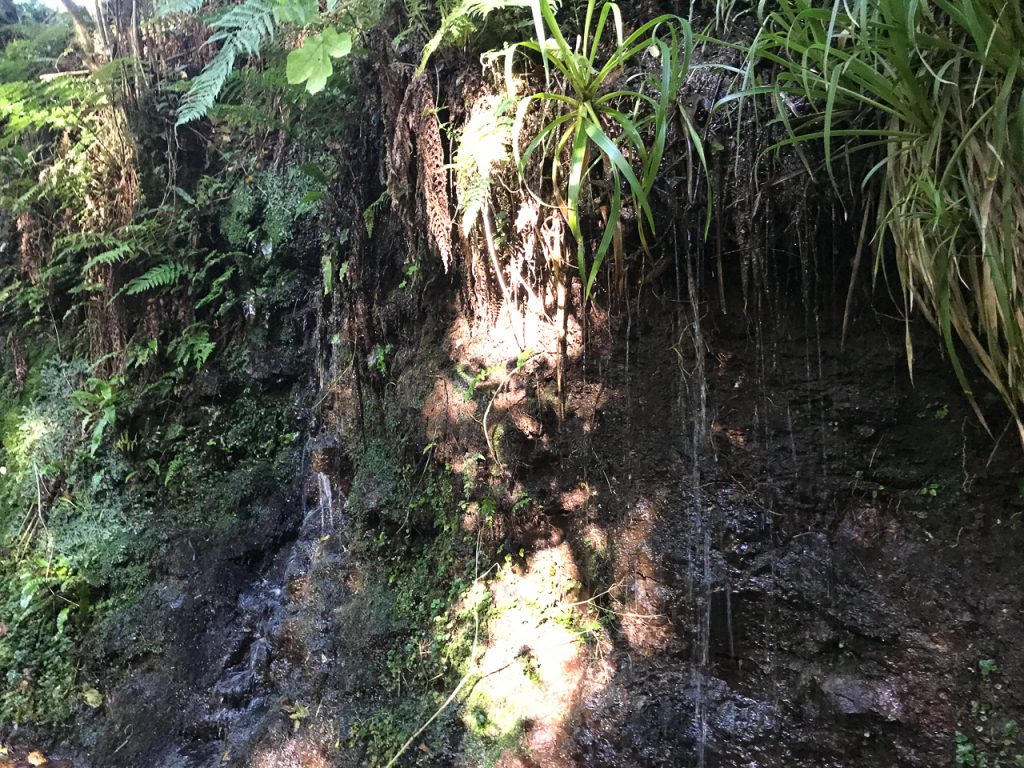
It’s funny how a chance conversation can you change one’s life. Since that conversation with Wendy, I’ve been unable to walk into a forest and not be mindful of what its telling me. I try to walk in silence…to notice details… to see what reveals itself.
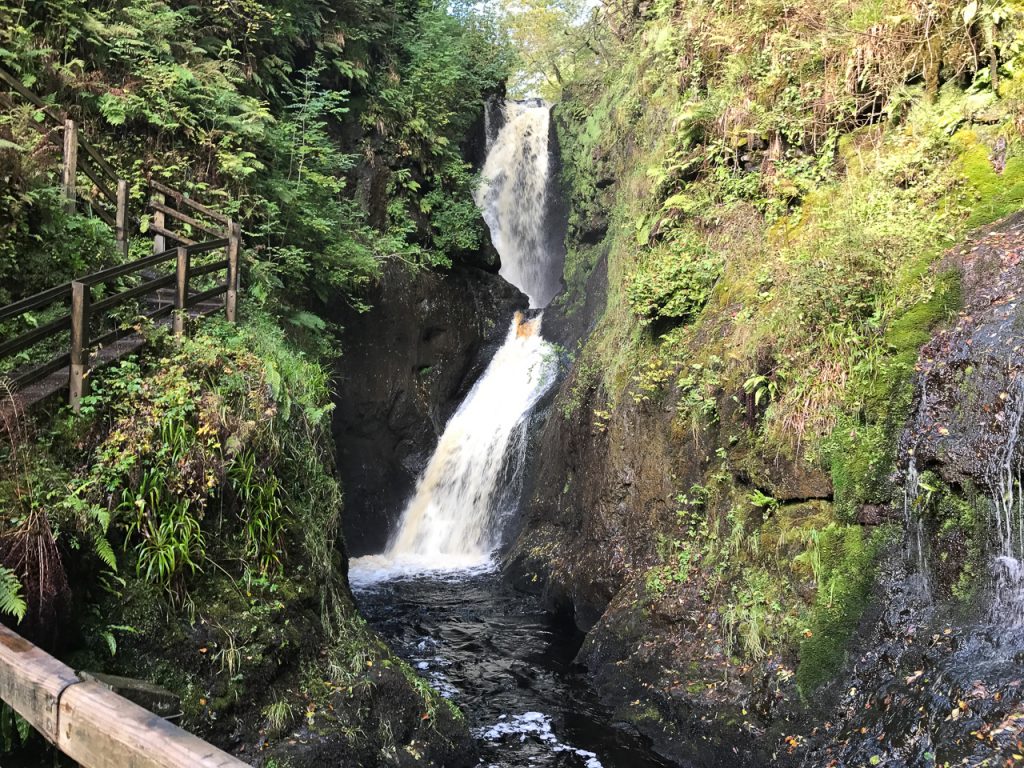
The Glenariff Woodland
In the Glenariff Woodland, there is a defined path that easy to walk. It winds into a gorge with rushing water, waterfalls, mist coming off of the rocks, all the mystical plants – ferns, ivy, holly, and a rare woodland plant known as “St. Patrick’s Cabbage.” The path is lined with oak, ash, willow and hazel trees.
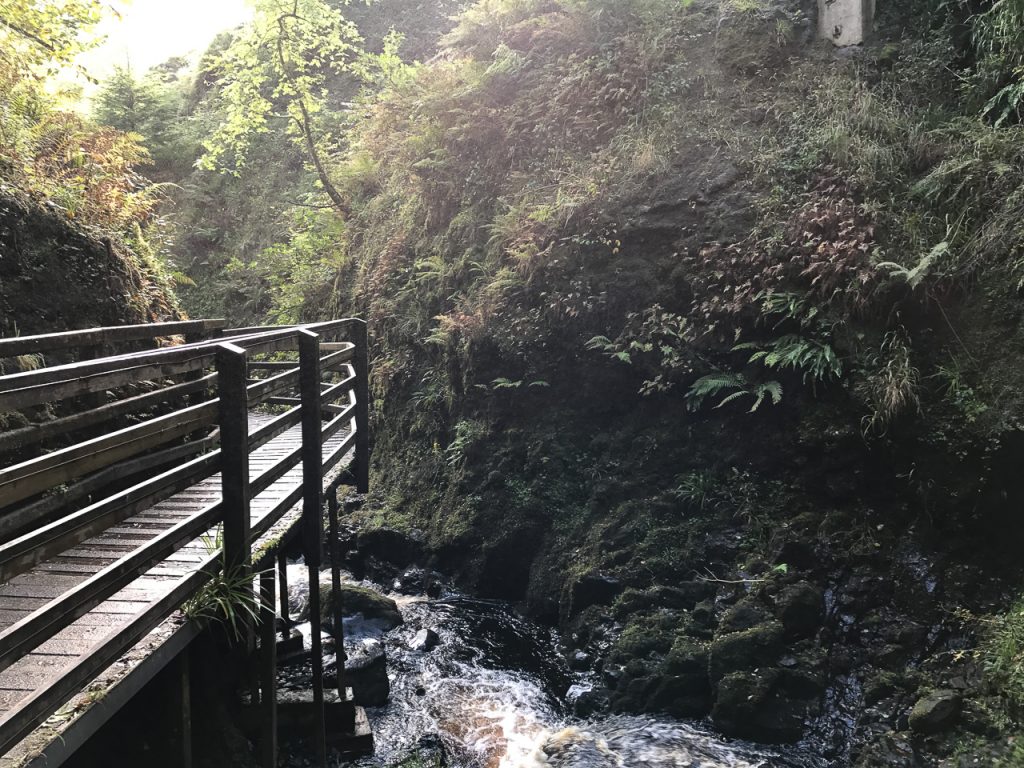
This forest was a stop on our Discover the North tour. I led my tour guests into this woodland and let them roam.
I stayed behind and then walked in silence…waiting for the woodland to speak to me.
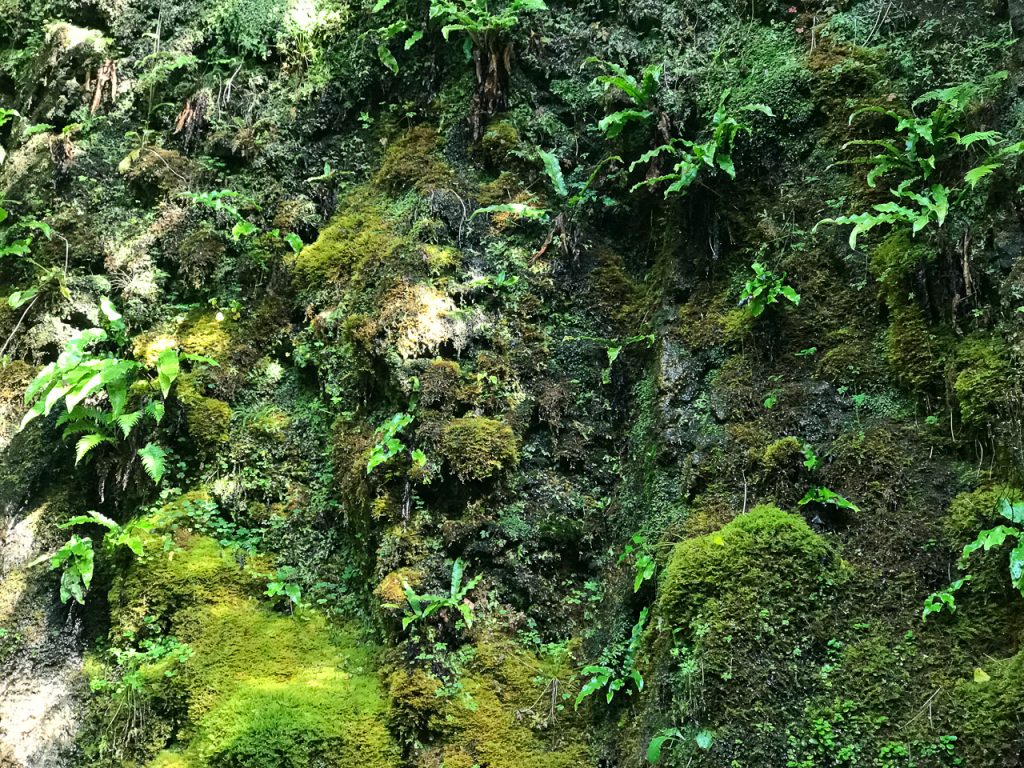
Faces in the Rock
There was a holy well along the path that had a few clooties tied to branches in the rock face.
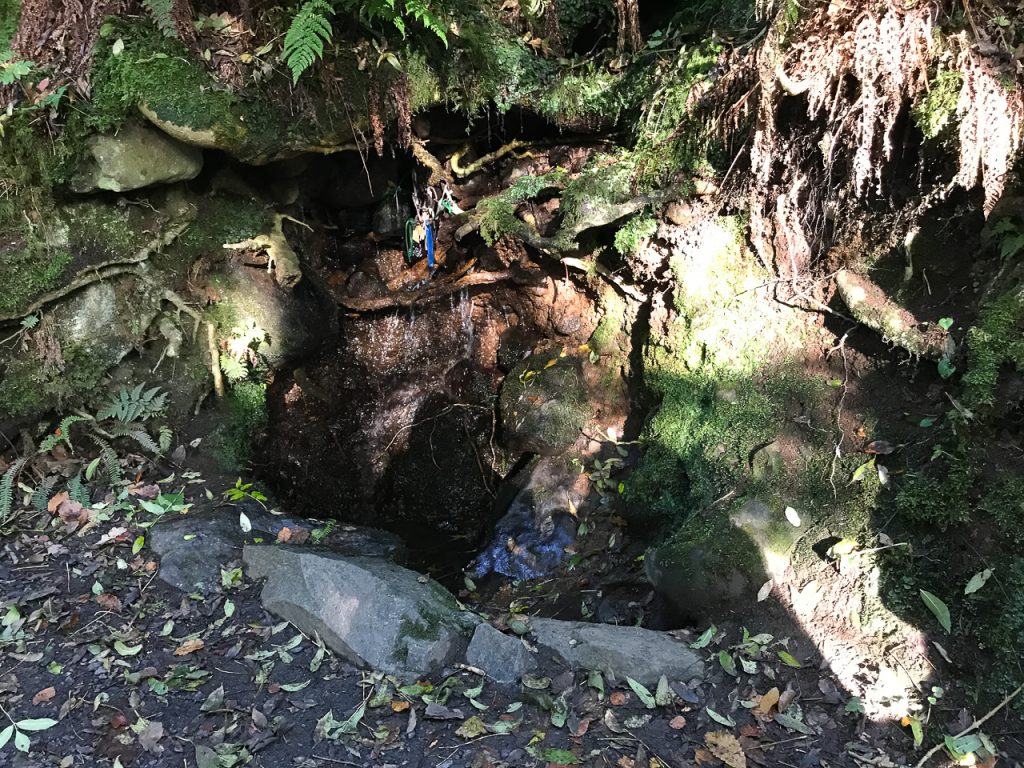 As my guests passed by me, they seemed to walk in silence too, though I hadn’t instructed them or encouraged them to do so. They were all so happy in that woodland. I stopped for a moment where the gorge wall rose steeply above the path – almost perpendicular to where we stood. In that time of reflection waiting for the woodland to “speak to me” I started to see faces – hidden in the rocks, moss, ferns and the watery surface of the gorge – – many faces. Faces made from the natural elements.
As my guests passed by me, they seemed to walk in silence too, though I hadn’t instructed them or encouraged them to do so. They were all so happy in that woodland. I stopped for a moment where the gorge wall rose steeply above the path – almost perpendicular to where we stood. In that time of reflection waiting for the woodland to “speak to me” I started to see faces – hidden in the rocks, moss, ferns and the watery surface of the gorge – – many faces. Faces made from the natural elements.
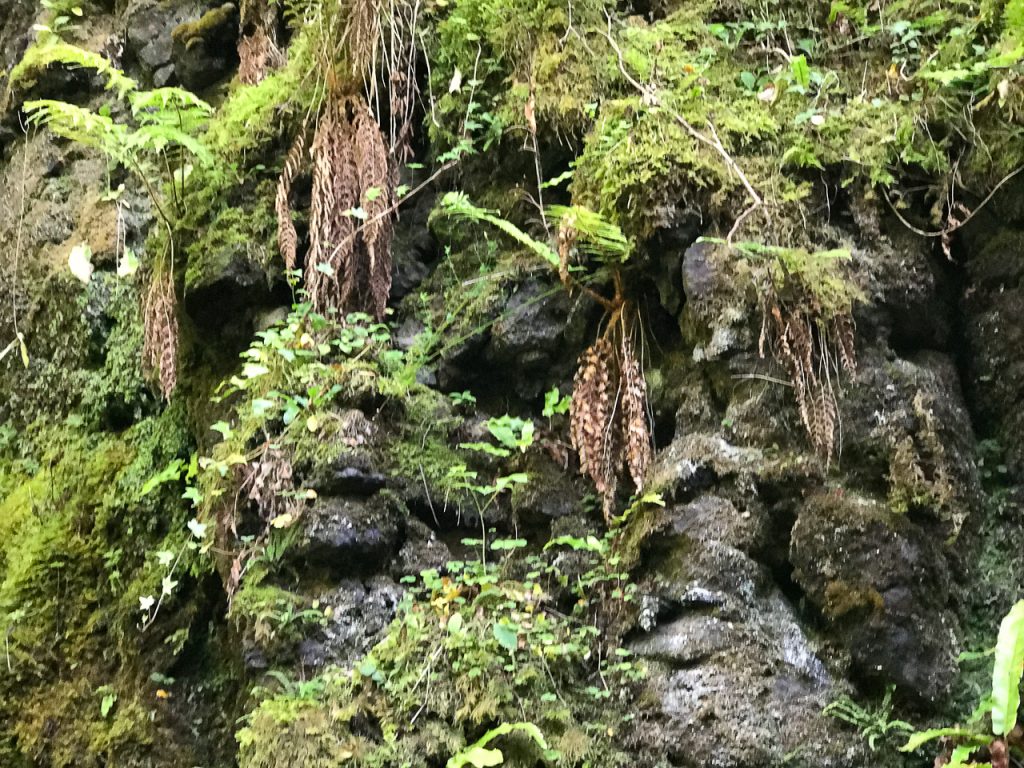 I pointed this out to my guests when they passed, and they saw them, but weren’t moved by them – not like I was anyway.
I pointed this out to my guests when they passed, and they saw them, but weren’t moved by them – not like I was anyway.
The Glenariff Waterfall Nature Reserve
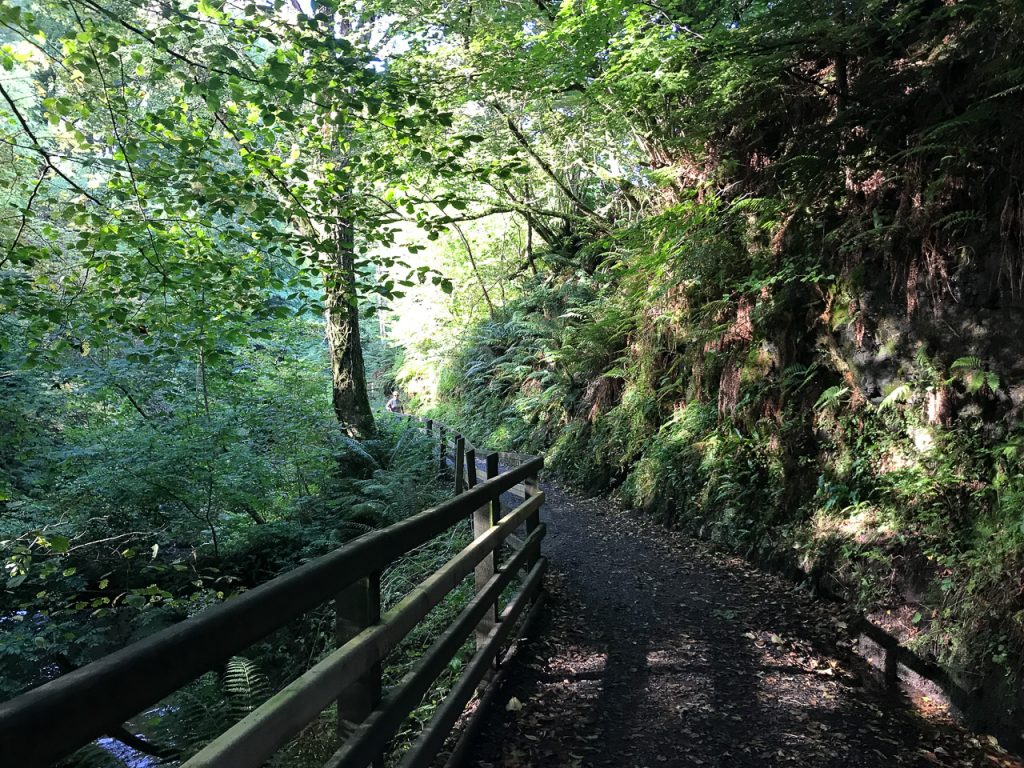
Glenariff Waterfall Nature Reserve is in the Glens of Antrim. Glenariff the largest of the nine Glens and many think it’s the most scenic. This entrance to this woodland path is located behind Large Lodge, a seasonal restaurant that has a wonderful ambiance and good food. You can park in the Lodge’s lot, have a bite to eat and then amble along the gorge path. The complete walk is about 1.5 miles and has steps and gets steep at times. But those who can’t negotiate the stairs can still enjoy the beginning of the trail.

The waterfalls and woodland are magical. Maybe you’ll see the faces.
The Glenariff Woodland Walk is on the Discover the North tour of Ireland.
A Bridge to the Otherworld – A Rainbow at Beltany
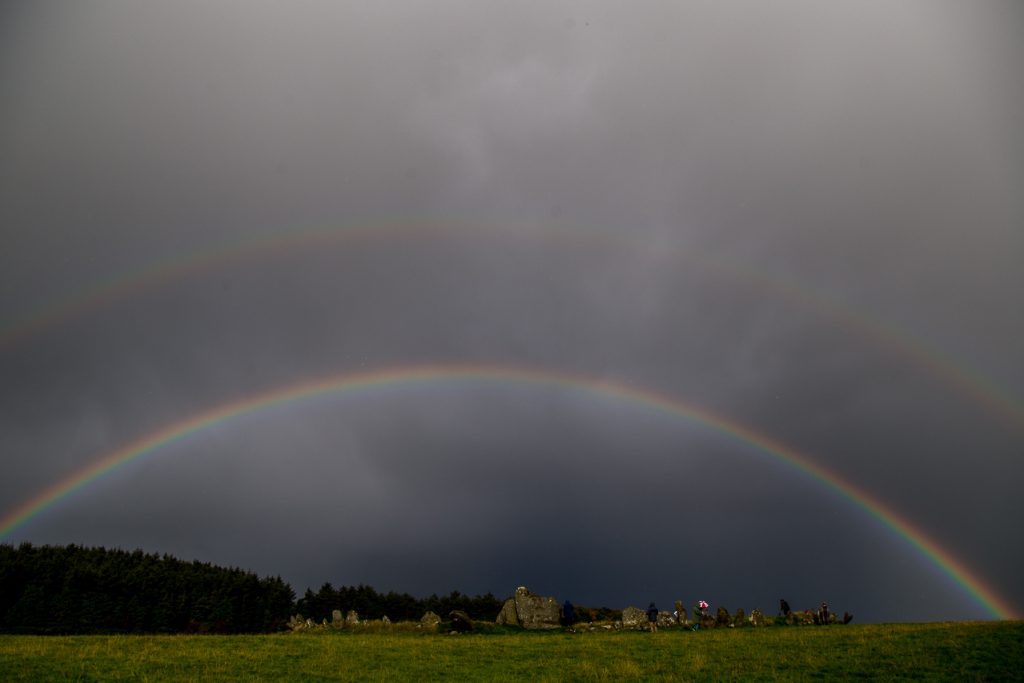
It appeared as if it was a bridge to the Otherworld… the rainbow we saw at Beltany stone circle on the eve of the Autumnal Equinox. The vision was certainly otherworldly. After seeing such a display there’s always the urge to make some kind of sense of it. To find some meaning.
Every culture has its own symbolic meaning for the rainbow. Most traditions focus on connection, a bridge to the otherworld, a promise from God, a sign of hope, a call to follow one’s heart. On the eve of the Autumn Equinox, I led a group up the path to Beltany stone circle in County Donegal. It was wet, rainy and overcast. The field approaching the circle was littered with cow dung. Several of my group turned back finding nothing particularly mystical about Beltany. But for those of us who stayed, the landscape shifted dramatically within fifteen short minutes.
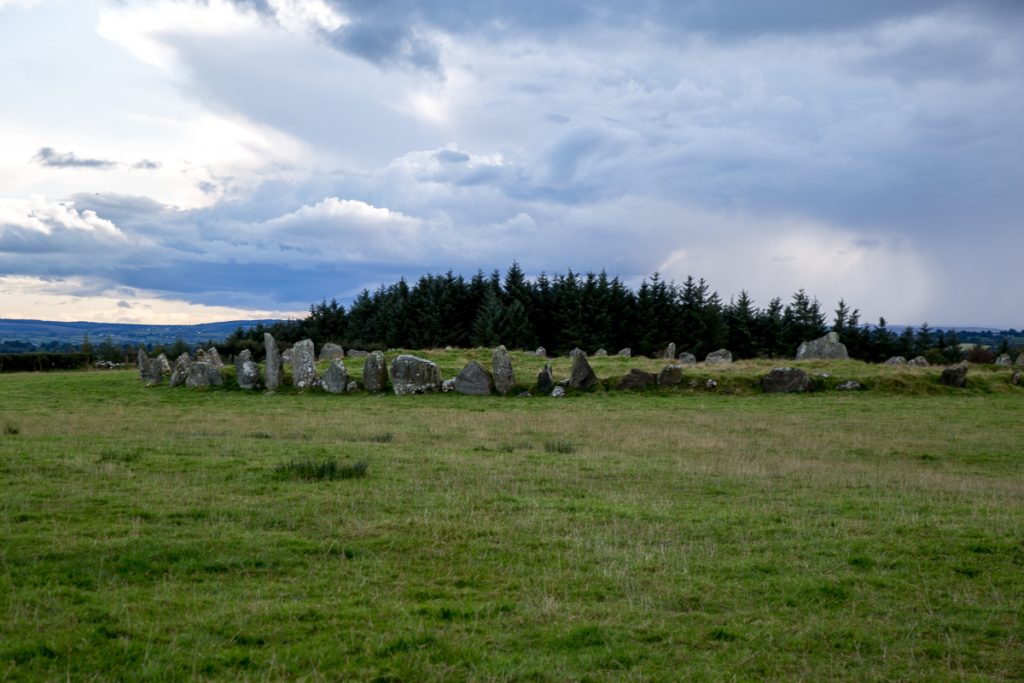
Beltany stone circle dates back to 1400 – 800 BC. With its 64 stones averaging 6 feet in height, it is larger than most found in Ireland. The circle measures about 145 feet in diameter. The site was significantly disrupted during an early twentieth-century excavation leaving the center of the circle lumpy with stones now covered by grass.
Most believe that there were at least 80 stones in the original circle. A wide triangular stone with cup markings immediately draws the eye and stands out from the others (shown to the right in the image above). It faces ENE and stands directly across the circle from the tallest stone (about six feet high) which points WSW. When the two stones align they point to the summit of a hill across the valley. On May 1st – the feast of Bealtaine – that the sun rises over that hill and aligns with these two stones. The circle’s name, “Beltany” likely refers to this celestial event and the feast of Bealtaine.
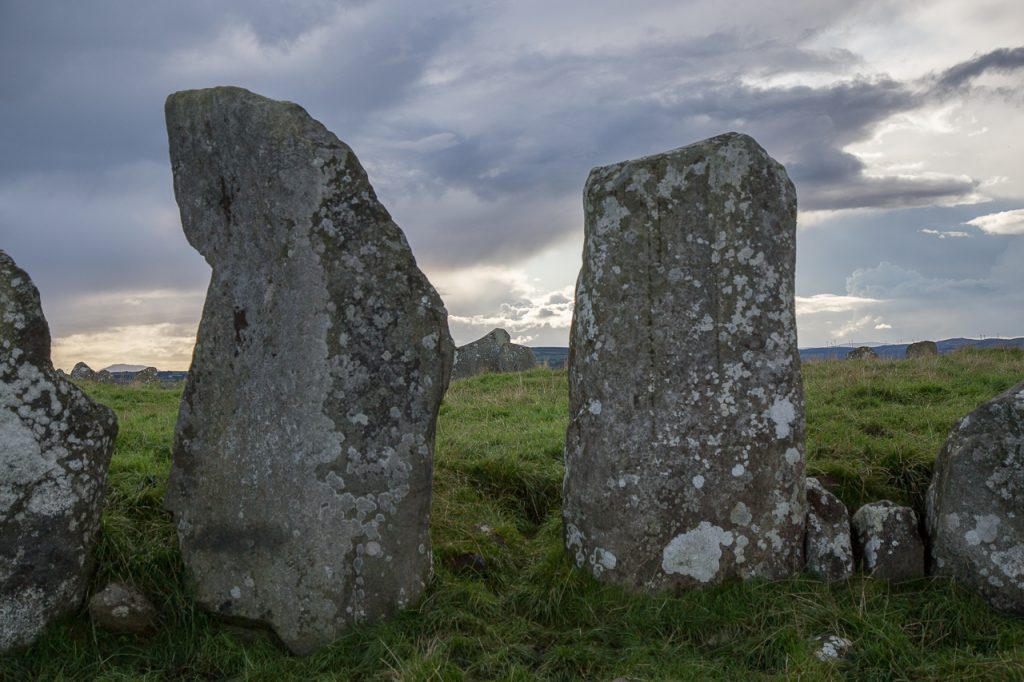
The Rainbow at Beltany
As we walked up the secluded path to the open field where the circle stands, my tour group was tired, the skies were gray and there was a slight drizzle. I was disappointed because I wanted my guest to love the circle as much as I did, but I could see that some of them remained on the bus and others exited quickly due to the difficulty of walking through a wet cattle field. I had only a portion of the tour group at the circle. Then it started to pour.
My heart sank. I want so much for this to be a perfect experience. But sometimes the weather won’t cooperate.
But sometimes the weather and the landscape surprises us.
As the rain softened, I happened to turn around toward the entrance to the field. I saw a pretty vibrant rainbow that was halfway across the sky. I called out to my tour guests to look at it. No one said a word – we just stared.
Then together we watched this rainbow spread perfectly across the sky over the circle. Then a second one appeared over the first. The clarity of the colors was stunning. Then we noticed that there was a darkness or shadow between the two bows. The space between was charcoal colored – different from the sky making the set of rainbows appear to be one thing.
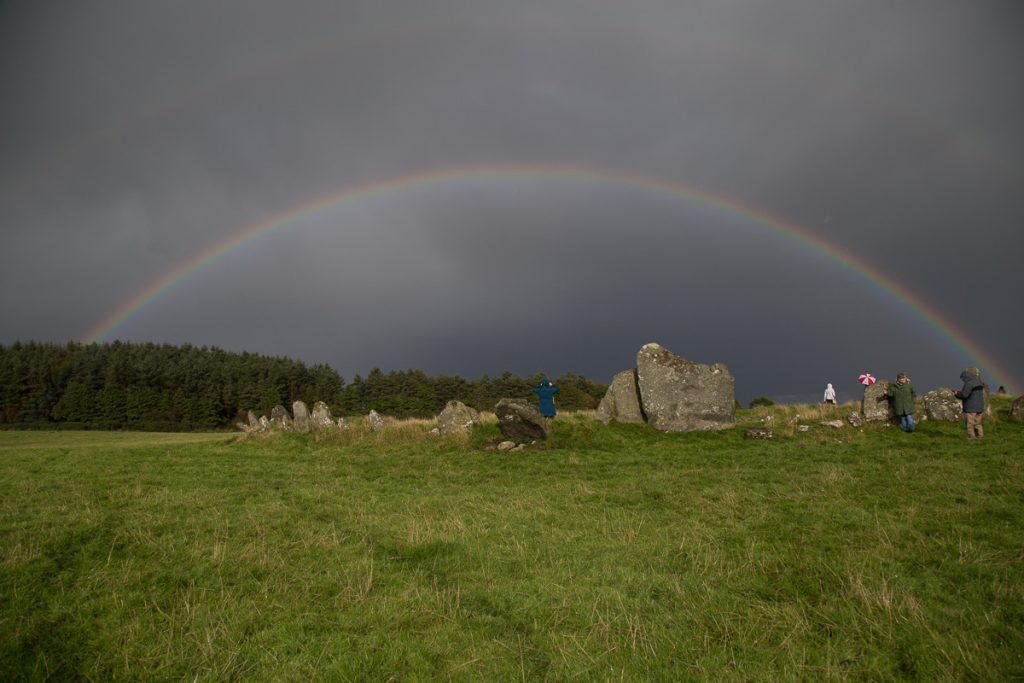
Even the sheep in the field were looking up at the rainbow.
One of my guests said, “In my seventy-one years of life, I have never seen anything like this.” It almost seemed as you could walk out to the end and touch the rainbow. Then the same guest pointed out that the colors were reversed on the second rainbow. Each rainbow was a reflection of the other with the colors going in opposite order – a perfect reflection – a mirror image. Traces of a third rainbow could be seen at the edges of the second.
The Symbolic Meanings of a Rainbow
A rainbow is a fusion of light that projects a harmonious – almost supernatural specter of all the world’s colors visible to the human eye. Every culture in every time has been moved by the sight of the rainbow. It nudges us to find some meaning in the presentation of something so spectacular. The Judeo Christian tradition is rooted in the book of Genesis.
It shall be, when I bring a cloud over the earth, that the rainbow shall be seen in the cloud; and I will remember My covenant which is between Me and you and every living creature of all flesh; the waters shall never again become a flood to destroy all flesh.Genesis 9:14-15
The first nations in North America, as well as many Asian cultures, saw the rainbow as a bridge or passage between the earthly and spirit worlds.
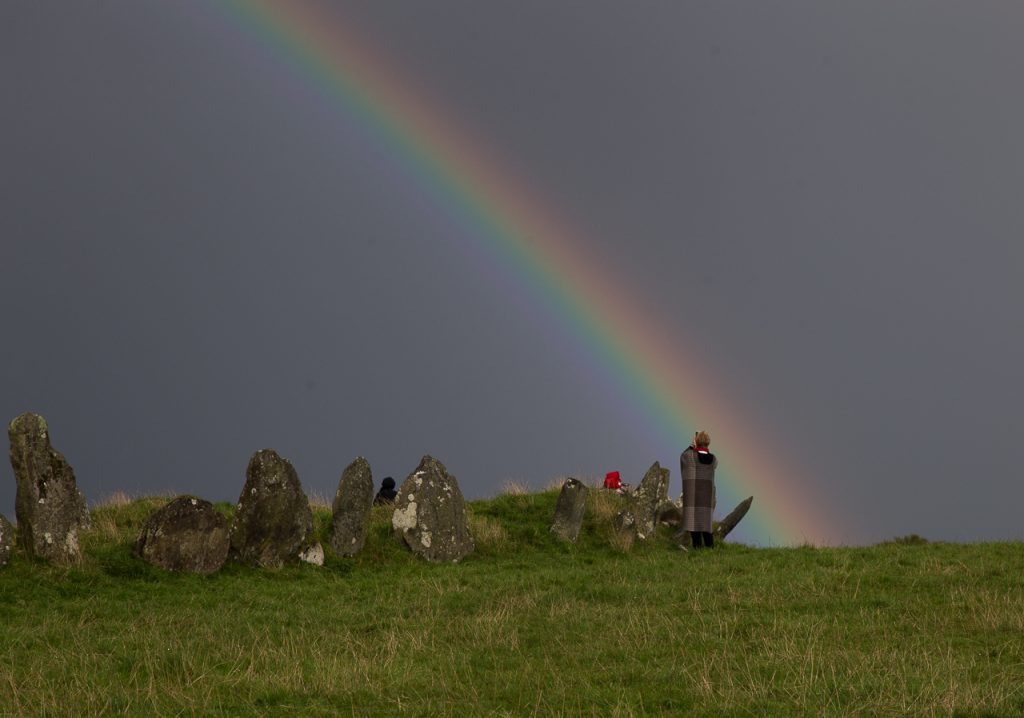
The ancient Irish or pre-Christian Irish saw the rainbow as a sign of blessing – the arc symbolized femininity – the rounded belly about to give birth, which is so appropriate for Beltany because the circle was likely created to celebrate that feast which encourages and blesses fertility and birth. The rainbow was often interpreted as a promise of good luck, abundance a sign to follow the heart’s desire or follow your dreams.
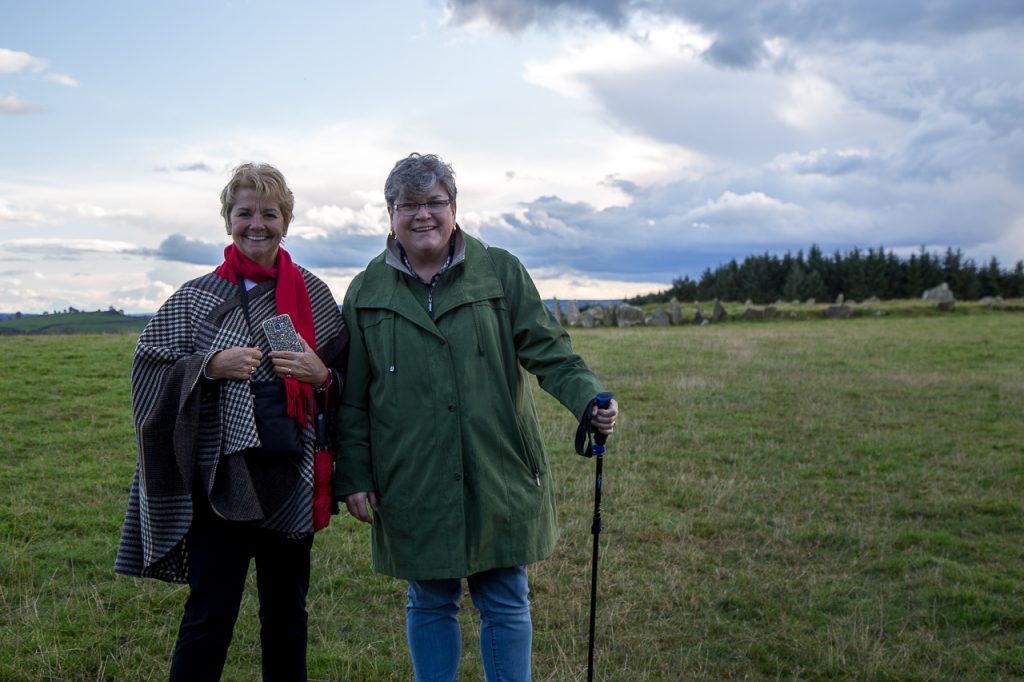
Guests on Discover the North tour after the rainbow
We’ve all heard of the old Irish saying to follow the rainbow and find the “pot of gold.” The rainbow was often interpreted as a promise of good luck, abundance a sign to follow the heart’s desire or follow your dreams. And standing at the edge of that circle and seeing the pulsing vibration of light against the field, one can perceive an actual “physical” end of the rainbow. Almost as if the pot of gold could be within reach. The light is mesmerizing.
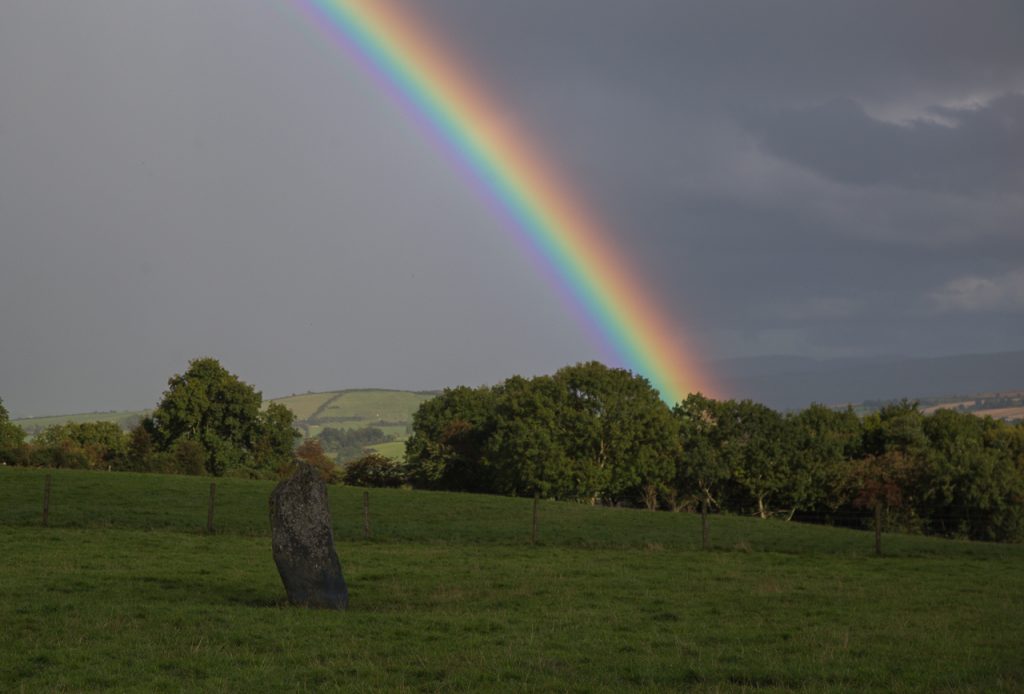
I love the kitschy words of the song from the musical Finian’s Rainbow
Look, look, look to the rainbow
Follow it over the hill and stream.
Look, look, look to the rainbow
Follow the fella’ who follows a dream
In the end, it doesn’t really matter what the rainbow means or doesn’t mean. Just standing in the presence of such a sight was gift enough for me. And it will always be a part of my memories of Beltany.
Fairy Tree at Grange Stone Circle
Fairy Tree at Grange Splits Stone
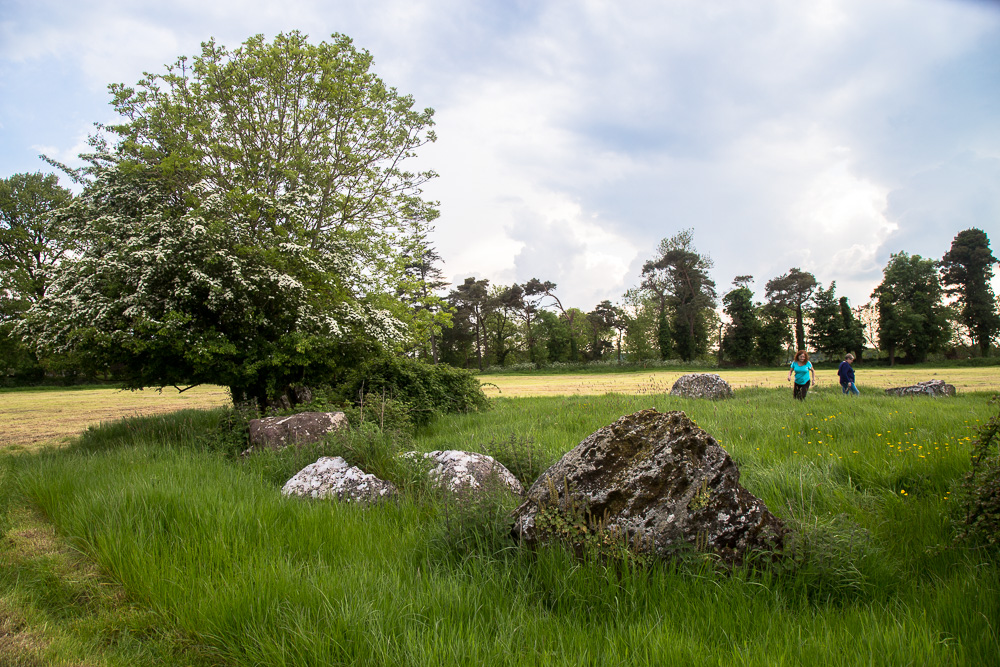
The fairy tree that split the rock at Grange Stone Circle II.
There is a fairy tree near the Grange Stone Circle has split on of the stone in two. The Grange stone circle in County Limerick is the largest in Ireland with 113 upright stones 150 feet in diameter. Many people don’t know that there is a smaller circle in the field next to the big one. And in that circle, the largest stone has a hawthorn tree growing out of it. The tree has split the stone in two and managed to thrive quite well.
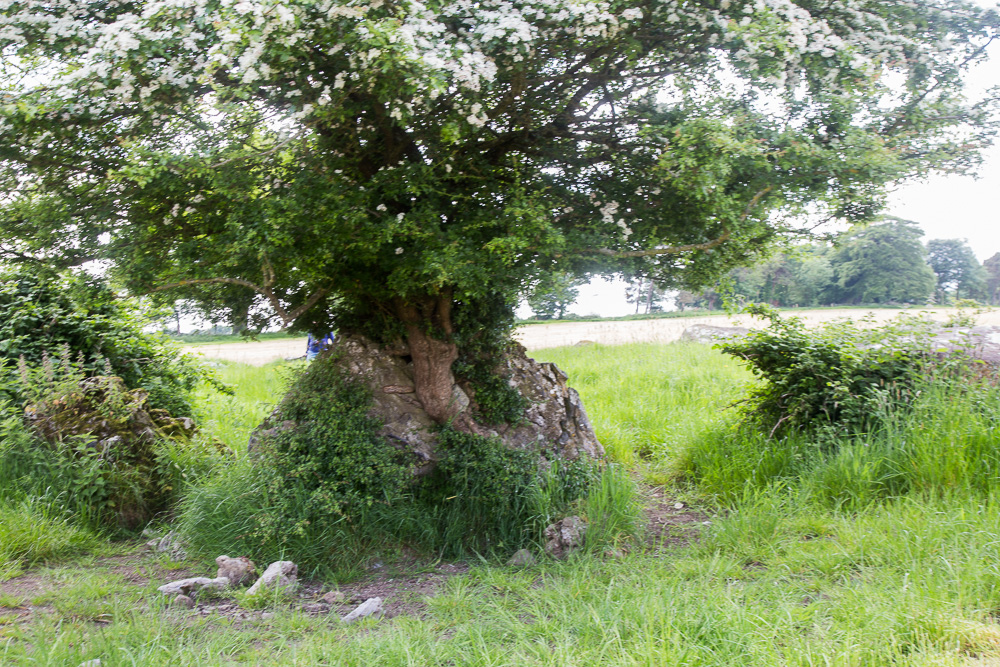
Further out in the same field is a tall standing stone and the farmer says that there’s another standing stone behind that one several hundred meters, though it is not visible to the naked eye.

The tree growing out of the rock is said to be a fairy tree or a mystical tree associated with elemental beings (non-human spirits) of another realm or world…. kind of a parallel universe. There are many traditional folk tales about the fairies and how they don’t like being disturbed… and if disturbed will bring bad luck. Most Irish people will dismiss these tales as pure superstition, but at the same time, they won’t disturb them. There is a respect for the mystical.
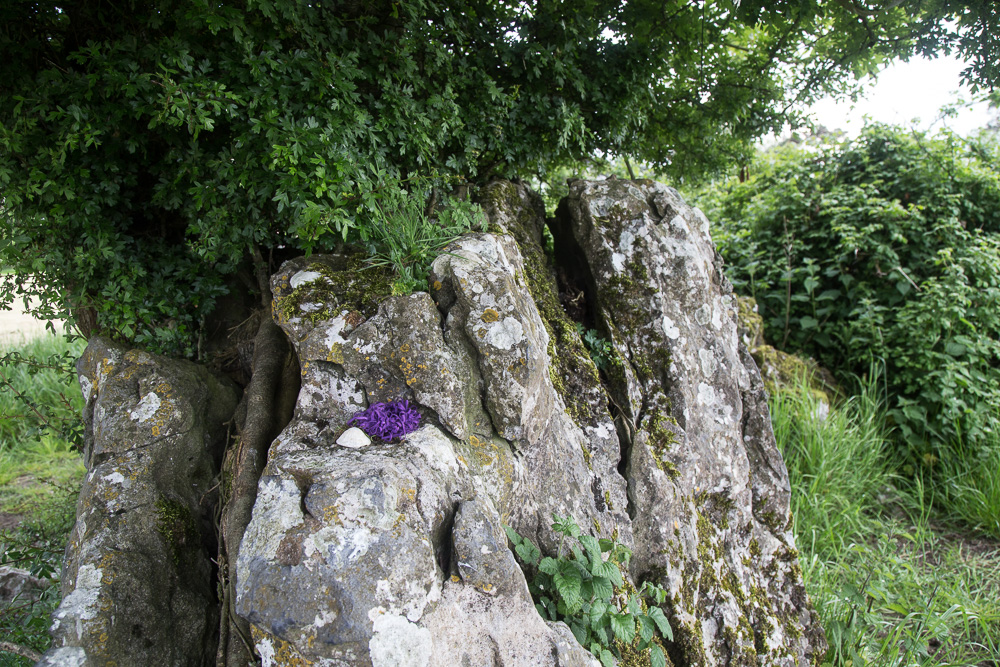
People still come to this tree and circle and leave tokens of devotion. You can see the purple ribbon and sea shell on the stone in the photo above. The entire region around the Grange and Lough Gur has an amazingly high energy vibration. I’ve taken groups there who have lost all sense of time in that place.
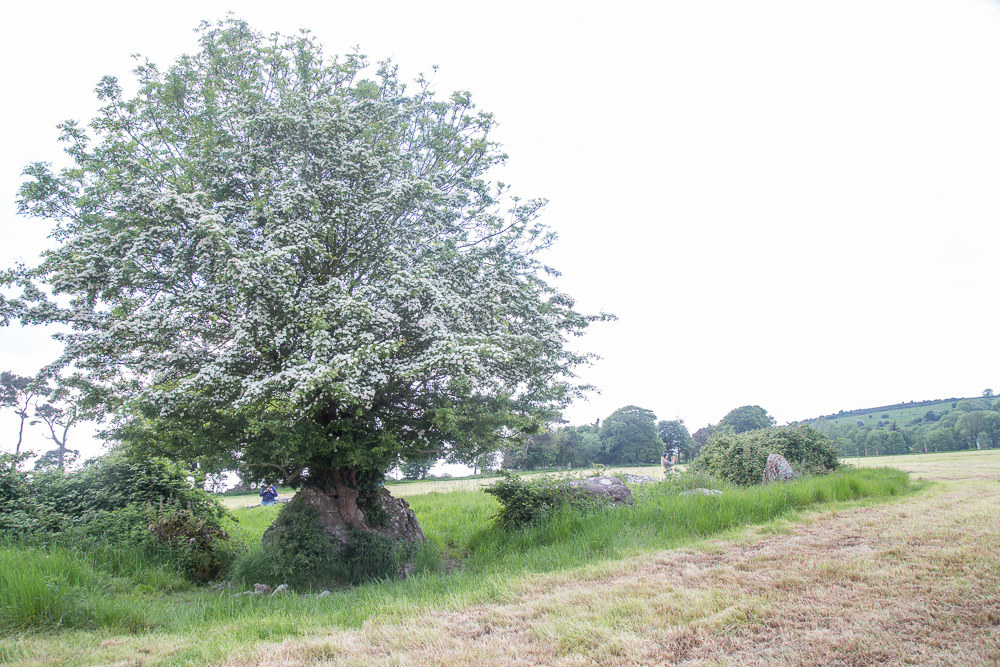
Fairy tree growing out of a rock – Grange Stone Circle II (smaller circle)
The Fairy Tree near the Grange Stone Circle and the surrounding sites are featured on the Places of Resurrection tour, Images in the Landscape Tour and Western Edges Tour.
Walking Meditation at the Hill of Uisneach
The Hill of Uisneach – a Thin Place

Guests at the Catstone on the Hill of Uisneach
The Hill of Uisneach is a thin place – one of those many luminal places in Ireland where the two worlds – physical and eternal – are fused together. It is an ideal site for being spiritually enriched by doing a walking meditation.
Few would realize as they drive along R 390 between Mullingar and Athlone, that they are passing through one of the most mystical places in all of Ireland – the mythological center of Ireland from where an ancient boulder marks the spot where all of the five provinces originate and come together… and beneath that boulder lies the goddess, Ériu, daughter of Ernmas of the Tuatha Dé Danann, earth mother of Ireland – and from whom Ireland takes its name – Eire or Erin.
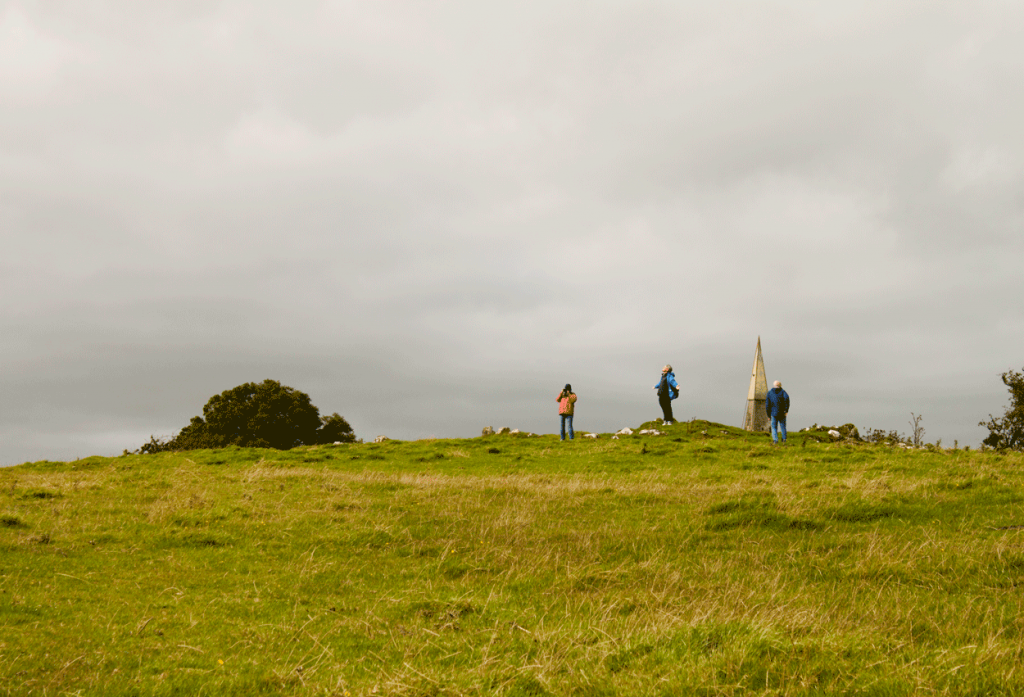
St. Patrick’s Bed on the Hill of Uisneach
From the pinnacle of the Hill of Uisneach, they say a person can see 20 counties. The Irish are always full of superlatives when they describe their archaeological treasures, but I will admit, the views are from that pinnacle – also known as St. Patrick’s Bed – are some of the most stunning I’ve seen in all my travels. The light seems to be different at Uisneach. The energy is riveting on this hill and its surrounds. And moving across this curvy greenscape of Uisneach dotted with stones, brush and lone hawthorn trees, one can see that it is a ripe setting for walking meditation.
Walking Meditation, the Process

Walking on the Hill of Uisneach
I learned about the process of Walking Mediation from my friend – and Brittany expert, Wendy Mewes. She does walking meditations with group tours that come to Brittany. The process that Wendy described is done completely in silence – even in a group. No one talks for the duration of the walk – perhaps 20 minutes.
As the walk begins, one focuses on the act of walking, moving through the landscape, being mindful of the body and the process of walking. Then one becomes mindful of the surrounding life force, noticing it in all living things around…sensing the force.. noticing that every living thing is charged with that divine presence, the presence of the creator – the great spirit – the source of all life and energy.
The third step of the walking meditation is to connect the two – your own life force with that of what surrounds you. What do the trees, the grass, the sky, the stones tell you? What do you hear from them? What do you learn from them? What are you sensing?
Sometimes, when the walking meditation is over, those on the walk discuss the experience and share what they learned, felt, were moved by, etc.
One can become totally consumed in mediation on Uisneach. The energy is overwhelming, and one can lose a sense of time and placement in the physical world. It’s no wonder that the ancients chose this spot for communal, spiritual practices. The Hill and its stories are tied to a tradition of spiritual power, rituals, traditions and mystical occurrences. It is one of Ireland’s most sacred sites.
Uisneach – site of the Bealtaine Fires

The Pinnacle – St. Patrick’s Bed – the Hill of Uisneach – The Bealtaine fires were lit near this site
Uisneach is said to be the spiritual and mythological center of Ireland – the Axis Mundi – Ireland’s naval – the joining point where all of the provinces come together in the center of the country, as well as the joining point between two worlds – the mystical and the physical. Archeological excavations show that Uisneach was likely a fire ritual site – a large one – a place where many people came together and celebrated the feast of Bealtaine.
The Catstone and Enchanted Lake

At the Catstone on the Hill of Uisneach
On the slope of the hill is Uisneach’s most famous landmark. The Aill na Mireann – meaning the stone of divisions, also known as the Catstone (so named because it resembles a crouching cat). This 30-ton limestone boulder that stands 16 feet high sits solitary on the lonely hillside. It was believed to not only mark the intersection of all five of Ireland’s provinces, it’s also said to mark the grave of Ériu, the mother goddess of Ireland, the one whom Ireland – Eire – is named for.
Uisneach was also said to be the site of one of the five great trees of Ireland – The Uisneach Ash – planted by Fintan the Seer who is said to have divided Ireland into its provinces with the stone at the dividing point – calling for there to be knowledge in the west, battle in the north, prosperity in the east and music in the south with royalty in the center. The Stone of Divisions. Since the stone touches every province, it also shares each province’s virtues. Thus we have the concept of all provinces meeting at Uisneach, and it being the mystical and mythological center of Ireland.
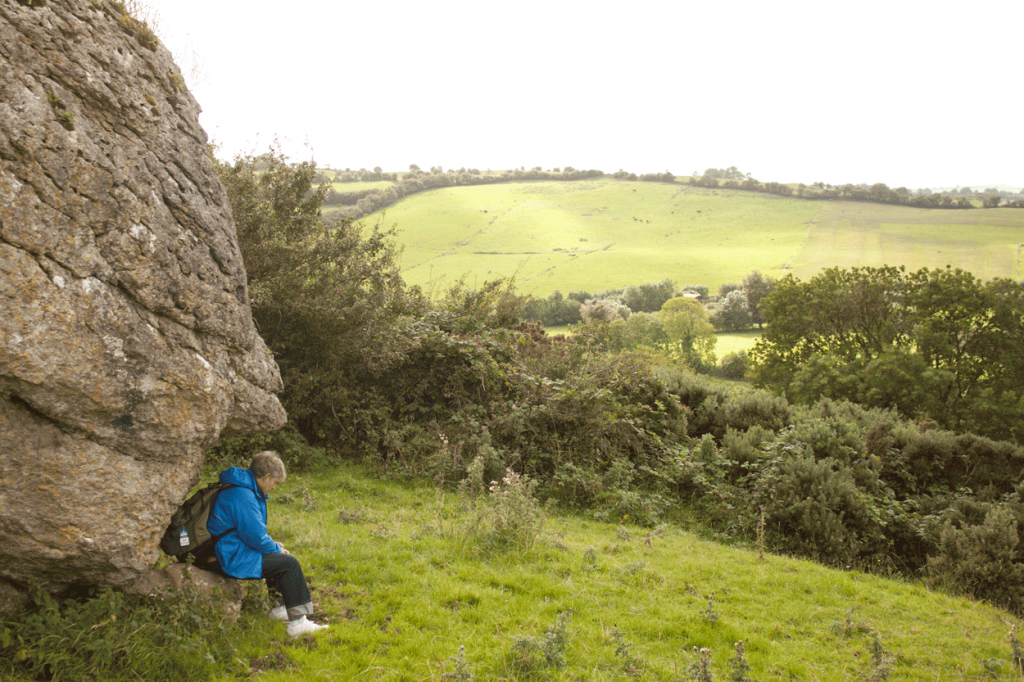
Sitting on the Catstone at the Hill of Uisneach
There have been people tracking ley lines throughout Ireland who see a common pattern with many lines leading to Uisneach. High Kings were once crowned at Uisneach before the Hill of Tara became the royal center for the country. So the legendary mystical character of the site goes back thousands of years.
There is a small (some believe enchanted) lake on the hill dedicated to Lugh, a member of the Tuatha Dé Dannan also known as the sun or harvest god. Legend states that Lugh battled with his brother on this hill and was drowned in the lake and buried under a nearby mound. Some believe the lake is enchanted.

Lugh’s Lake on the Hill of Uisneach
Not too far from Lugh’s Lake is the foundation of the old palace that sat atop the hill. Located in one on those grounds is another stone – nicknamed “the money stone.” It’s short and appears to have petrified wood drilled into it. The stone has amazing energy, and if you place your hand a few inches away from it, you can sometimes feel the energy coming off of it in the form of heat or a vibration. Using dowsing rods on the hill, we found the magnetic pull coming – not from the Catstone, but from the money stone. I’ve not been able to trace the origin of the name of that stone but can encourage people to seek it out.

Under the Fairy Tree – Hill of Uisneach – Images in the Landscape Tour 2015
Considering the ancient fire rituals, royal traditions, legends of the goddess, the Capstone, Money stone and enchanted lake, Uisneach is truly a mythological mecca for those who seek out thin places. A walking meditation here, is powerful food for the spirit.
Top Books to Read on Southwestern Ireland
Here is a list books I found helpful in giving a good overall background of the southwestern region or understanding the sites we’ll be traveling to on the Places of Resurrection tour. Some of them are specifically targeted at mindful travel, making the most of traveling to thin places.
Preparing for Travel to Thin Places
A visit to a mystical site is powerful whether or not you have any understanding of the history or legends associated with that site. But the more understanding you have about a site or about the landscape, the greater the possibility for inner transformation.
Prepare by growing your understanding of earth energy, ancient local traditions and the people of the place and you will be less curious about the facts associated with the site, and more able to absorb the power each site generates. These books are simply suggestions that might help you prepare.
Before you Go – Mindful Travel
Every Ancient, Ever New, by Dolores Whelan – This is a short book with a little over 100 pages, but Dolores gives a solid perspective on how to use the understanding of ancient Celtic traditions to create a new way of seeing the world – of being in the world. This is one of the best books for understanding thin places and what they mean today.
NOTE: The price for this book on Amazon.com fluctuates based on their ability to get the inventory from Ireland. So try ordering directly from Dolores Whalen’s website ($23) of the Amazon price is high.
Ley Lines and Earth Energies, by David Cowan & Chris Arnold – This was the first book I read about the concept of earth energies and how the ancients may have been able to sense those pulsating movements when they built their stone circles, passage tombs and other monuments. We will be doing some dowsing on our tour, so an understanding of this concept will be very helpful.
Awakening to the Spirit World, by Sandra Ingerman & Hank Wesselman – This is one of the best and simplest books on understanding Shamanism and Shamanic practices, which are a way to “journey” to otherworlds in order to gain wisdom. It’s a great primer for understanding the “otherworld” concept and being sensitive to other realms as you move through thin places.
Walking With the Sin Eater, by Ross Heaven – This is a might lighter look at Shamanism and can be read in a few hours. It’s set as a personal memoir of journeying, but reveals some great truths about earth energies and spiritual transformation through journeying.
Region Specific
These books, written by local Irish and travelers to Ireland reveal the hidden landscape, culture, history, folklore and traditions of places in the southwest particularly Dingle, the Aran Island and the Beara Peninsula.
DINGLE
Peig, by Peig Sayers – This is out of print, but you can get used ones from Amazon for a good price. It’s an autobiographical account of a woman who grew on the Dingle peninsula in the early 20th century, but married and moved to the Great Blasket Island and lived a hard life. She only spoke Irish dictated her life’s story to her son who wrote down. It was later translated and is now considered one of the great publications in Irish literature. It also gives insight into the culture and landscape of Dingle, the Blaskets and southwest Ireland in general and the harsh life that formed much of the Irish perspective that we see today.
Twenty Years A-Growing, by Maurice O’Sullivan – First published in 1933, this book, like Pieg is a memoir of O’Sullivan’s life on the great Blasket Island. But this book has a much livelier slant. It’s rich in storytelling, folklore of the southwestern region, and impeccable at describing the landscape and our connection to it.
Climbing Brandon, by Chet Raymo – Raymo is a science writer out of Boston who spent summers on the Dingle. He writes about the holy mountain on Dingle named for St. Brendan the Navigator. His eloquent writing style alone makes the book worth the read, but he gives great insights on the Dingle Peninsula, its legends, culture and the conundrum of making sense of religion with such a strong background in science. His perspective is “in the portal between knowledge and mystery, between the commonplace and the divine.”
THE BEARA PENINSULA
At the Edge of Ireland, by David Yeadon – A travel writer’s perspective of the Beara Peninsula, which is the least traveled of all the southwestern peninsulas. Yeadon and his wife spent time on the Beara and he wrote a funny account of that travel which encompasses everything that is the Beara Peninsula – the villages, the ancient megaliths, the mountains, culture, music, bar scene and more. It’s a comprehensive view of what Leon Uris called “the Terrible Beauty.”
McCarthy’s Bar, by Pete McCarthy – a very fun book written by travel and screen writer Pete McCarthy who traveled from the west coast of Ireland from Cork to Donegal obeying one rule of travel – “Never pass a bar with your name on in.” The cover of this bestselling book shows McCarthy’s Bar in Castletownbere on the Beara. Lots of humor. An entertaining read that reveals the magic of Ireland and its people, but also a good account of the Beara Peninsula and the southwest coast.
THE ARAN ISLANDS
The Aran Islands, by John Millington Synge – Between 1898 and 1901, the great Irish literary figure, John M. Synge traveled to the Aran Islands to observe the landscape and culture of the islanders. This short, little book is a beautiful account of the old folklore, language and traditions that were once at the heart of all of Ireland. One can get a good sense of the Aran Island landscape and people – even the Aran of today by reading this book.
IRELAND IN GENERAL
Legendary Ireland, by Eithne Massey – This book focuses on the myths and legends of Ireland that are associated with places. While several of the sites listed such as the Hag of Beara and Áine of Knockainey but the book itself gives an understanding of how the Irish linked the landscape to the stories, and their perception of a mystical chord that knits that mystical world of myths and legends to our present world.
Let us know your favorite books that reveal the mystical nature of Ireland’s southwestern region including counties Cork, Kerry, Clare and Galway. Put your thoughts in the comments.
The Mystical Faces of Harry Clarke in Dingle
Harry Clarke – Icons in Stained Glass
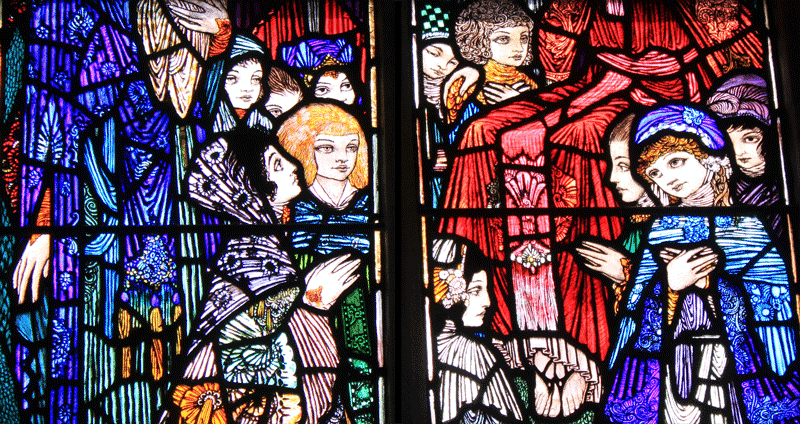
Harry Clarke,famous for his stunning stained glass windows scattered all over Ireland, crafted a series of windows depicting the life of Christ that now hang in an obscure chapel in Dingle. To see one Harry Clarke Window is a gift. To see twelve at once is an mystical experience.
The Dingle Peninsula in Ireland’s south west corner is a magical place. Apart from the well-known sites like Slea Head, Gallarus Oratory, the mysterious Blasket Islands, bee hive huts, and Mount Brandon, the Harry Clarke windows in the Chapel of the Sacred Heart at the old convent of the Presentation Sisters are hidden jewels often undiscovered by the traveler who walks the streets of Dingle town.
Perhaps it’s no wonder that Dingle – one of the thinnest places in Ireland – drew unto itself one of the largest collection of Harry Clarke windows installed in a single location.
The windows are housed is a small chapel situated next to St. Mary’s Church on Green Street. Visitors can stop in the An Diseart Visitor Centre and ask for a guided tour, or contact the Centre ahead of time and secure a appointment to view the windows. The young woman who conducted my personal tour explained that this was once a convent and the chapel was solely for the nuns. They were the only beneficiaries of this magnificent art except for on rare occasions.
Illustrator turned Stained Glass Artist
Harry Clarke was the son of a craftsman. He started working with stained glass under his father’s direction when he was in his teens. After he completed his education, Harry Clarke began his professional career as an illustrator. His illustrations adorned books of fairy tales by Hans Christian Andersen and Edgar Allen Poe. It was Clarke’s craftsmanship as an illustrator that set his stained glass windows apart from other famous stained glass artists. The detail to fine lines and his method for using lead to carefully outline his figures was unique. His use color, particularly his shades of blue, made his windows stand apart.
This little chapel next to the grand St. Mary’s Church houses twelve lancet stained glass windows by Harry Clarke. Many churches in Ireland will claim one Harry Clarke window as an element to attract visitors. (And viewing one window IS worth a visit anywhere). But to have twelve all together in one spot is enough to take one’s breath away. Each pair of double windows depicts one of six scenes from the life of Christ – Visit of the Magi, Baptism by John the Baptist, Suffer the Little Children, Sermon on the Mount, Agony in the Garden, and Christ’s Appearance to Mary Magdalene.
The Faces in the Chapel
The faces of Harry Clarke’s characters in theses windows draw the admirer into the work of art – connecting on a deep level. The eyes of the figures follow you as you move around the chapel, and the expressions on the faces are full of emotion. They haunt you after you leave.
The series of windows transports the gazer … lifts the spirit into another realm. They stimulate the imagination.
In 1929, mystical writer George Russell (aka AE) wrote, “Harry Clarke is one of the strangest geniuses of his time … He might have incarnated from the dark side of the moon.” ~The Irish Statesman
Viewing the Harry Clarke Windows at the Diseart Centre
If you’re in Dingle, ask about the Clarke windows. Anyone can direct you to St. Mary’s Catholic Church. The former convent – now theAn Diseart Visitor Centre is next door. Only escorted tours are offered and the hours of operation for the Centre vary so call ahead and inquire about a guided a tour.
The tour takes about and hour and there are beautiful walled gardens as well as a hidden tunnel that can be explored with a guide. But make the chapel the last thing you see, because everything after that will be underwhelming.
The Harry Clarke windows in Dingle are on the Places of Resurrection Tour in 2015
12 Pictures that Will Make You Want to Tour Ireland
Ireland and its thin places have such a draw for those interested in traveling a bit deeper into the landscape. Here are 12 pictures that show some of these amazing places. All of them are on our Castles, Saints & Druids Thin Places tour this September 2014. Join us!
1. The King Oak
The King Oak is said to be between 500-800 years old. It’s part of an ancient oak forest once sacred to the Druids, then later the site of a monastic community. The forest entombs Charleville Castle, a gothic-style castle built from 1798-1812. The King Oak ranked #3 in Europe’s Tree of the Year 2013 and it’s a familiar old spot to the people around Tullamore. Many a romance started and ended beneath the branches of this tree. The spread of the lower branches spread out over 150 feet from end to end. This oak is set in an ancient grove with other trees that are hundreds of years old. When the British invaded Ireland and occupied the country, they ravaged the land, stripping it of all its forests, then exported the wood for profit. Fortunately this oak forest was part of a 1700 acre “gift” from Queen Elizabeth I to the Moore family. The gentry tended to keep the trees on land around their homes. This oak forest has been considered magical for centuries.
2. Charleville Castle
Charleville Castle was built by the Earl of Charleville between 1798 and 1812 in an ancient oak forest near Tullamore. The site was formerly occupied by the Lynally monastic community, and before that was used by the druids for sacred rituals and ceremonies. It is currently owned by a non-profit that uses volunteers from all over the world to help restore the castle and bring it into a self-sustaining existence. The caretaker says that the designers of the castle were Masons and positioned the round towers on crossed ley lines which creates a powerful energy field in the tower rooms. The caretaker also has experienced ghostly sitings that include druids, the Earls of Charleville and the castle designer. Many believe that a little girl named Harriet who was the daughter of the third Earl of Charleville haunts the back staircase where she fell to her death after trying to slide down the bannister. Charleville Castle and its surrounding oak forest is considered one of the scariest places in Ireland.
3. Castleruddery Druid Stone Circle
Castleruddery Stone Circle in County Wicklow is a Bronze Age Druidical circle once used for ritual. There are a total of about 40 stones on the site but the circle itself has about 20 standing stones places on a raised embankment. This would have been a place of great importance based on the geographic layout of the stones, embankment and ditch that is dug outside the embankment. Two large quartz stones mark the portal (entrance) of this circle. Quartz in an amplifier of energy and believed to have healing properties. Some locals from this area believe this stone circle has healing properties. There is also a fairy tree in the circle (pictured here). The roots are wound around a standing stone. Some of the stones have cup marks carved into them and notches carved across.
4. Glendalough
Set in the Wicklow Mountains, Glendalough (meaning valley between two lakes) features the ruins a Medieval monastic city founded by St. Kevin in the 6th century. In the last two centuries it’s been used as a graveyard for local families, but the old bones of the monastic city can still be seen in the hilly landscape. ruins of churches, round-towers, buildings dating from the 9th to 13th century make this site absolutely enchanting. The views of the glen and lakes and babbling stream connecting the lakes are also remarkable. Our Castles, Saints and Druids tour group will be overnighting in the Glendalough Hotel in September.
5. St. Kevin’s Kitchen – Glendalough
St. Kevin’s Kitchen is a 12th century church in Glendalough, and often used as a defining landmark for the ancient monastic city. The church has a stone roof with a round tower built into the roof. Round towers were used for bells, for look-out stations to see people approaching from a distance.
6. St. Berrihert’s Kyle – Glen of Aherlow
St. Berrihert’s Kyle is a round structure built by the local people from pieces of an old monastic ruin. It was made to mark a Cillini or burial ground for unbaptized babies and others not qualified for sanctified ground. The kyle is a complete circle set in an oak grove in the Glen of Aherlow in County Tipperary. Pilgrims travel from all over to pray here. They leave behind devotional tokens – some very rare. These tokens are offerings left in hopes that their prayers will be answered. There is also a holy well (more like a small pond) nearby that is flanked fairy trees covered in clooties, also left by pilgrims.
7. The Rock of Cashel
If the Rock of Cashel doesn’t inspire you, nothing will. This cluster of ruins atop a rocky hill in County Tipperary can be seen for miles. It always reminds me of Emerald City in the Wizard of Oz. The Rock is set in the middle of agricultural land known as the “Golden Veil” because of the bounty of food it produces, and that land is ringed by mountains. The views from the Rock are stunning, and the energy and power of the site radiates in almost fearsome abundance. This is a must-see site in Ireland.
8. The Hill of Tara
This is the Lia Fáil or Stone of Destiny perched atop the Hill of Tara – a corronation site once used for crowning the High Kings of Ireland. An old legend states that if the true High King was crowned, the Lia Fáil would literally cry out or roar. If this stone looks phallic to you, that’s because it’s meant to look that way. The ancient pagans didn’t have the sexual hang-ups of our present world. They believed that male and female were two aspects of the Divine. In this case the stone may represent the male Divine aspect in union with the female aspect (the earth). The stone is believed to have magical properties – those properties were demonstrated the roar of the stone during coronations. The Hill of Tara has a brilliant earth energy.
9. Newgrange Passage Tomb
Newgrange, the Boyne Valley is Ireland’s oldest building remaining fully intact. The tomb dates back 5000 years, predating the pyramids of Egypt, Stonehenge and all the other tombs and prehistoric enclosed structures in Ireland and Britain. Newgrange was a center for spiritual ritual and has remained intact since the Stone Age. The inside is large with a center chamber large enough for 20 people to stand and three side chambers. The entrance is shown in this image (center). Above the opening the tomb is a stone lintel which allows the passage of light to penetrate the pitch blackness of the tomb during the sunrise on the Winter Solstice (December 21) – the shortest day of the year. Visitors to Newgrange can walk deep into the passage tomb and a guide uses an electric light-beam to demonstrate the shift from dark to light during the Solstice sunrise.
10. Sheela-na-Gig – Kildare
There are people who search for Sheela-na-gig’s all over Ireland and in other Celtic countries. These figures are usually primitive carvings in stone that depict a female revealing her genitals with legs spread wide open … usually with some kind of angry face. Some say the Sheelas were fertility goddesses, others believe they a defense against evil or bad energy similar to the function of a gargoyle. They are often found over doorways or beside entryways in churches and castles. Ireland has the most known Sheelas of any country (101). This Sheela-na-gig is hidden under the altar at St. Brigid’s Cathedral in Kildare. As our Thin Places tour group wandered through this beautiful and ancient cathedral, one of the cathedral staff people pointed this out to me. It was tough getting a picture (had to practically lay on the floor), but it was well worth it.
11. Leap Castle
Leap Castle is still being restored by its owner, musician Seán Ryan and his wife. The castle located in County Offaly was built by the O’Bannon clan in the 13th century, and later came under the ownership of the O’Carroll clan. It is said to have been built on a former ceremonial site used by the druids, and archaeologists estimate there has been human habitation on the site since the Iron Age (500 BC). Leap is famous for being haunted, probably because of the violence that has occurred there. The O’Carroll clan, warring over leadership resolved the conflict when one brother (a priest) was saying mass for his gathered family members in the chapel on the upper floor of the tower. Another brother burst through the door and murdered the priest with his sword in front of the family. Thereafter the upper floor of the tower was known as “the Bloody Chapel.” Leap also has an “elemental” or non-human spirit that has been seen as a shadowy figure that makes mischief.
12. Kilkenny – Downtown
While we all love thin places and mystical landscapes, no travel to Ireland is complete until the visitor gets to experience the Irish culture, and Kilkenny is certainly a vibrant town of culture. The name Kilkenny originates from the Irish words that mean Church of Canice and St. Canice’s Cathedral and round tower sitting atop a hill anchors one end of the city while Kilkenny Castle anchors the other. In between are shops, galleries, pubs and heritage sites. This was once a hub for monastic communities. The Grey Friars were here as were the Franciscans – St. Francis Abbey is now home Ireland’s oldest operating brewery which makes Smithwicks and Kilkenny beer. Walking the Kilkenny’s downtown is an excellent way to engage in conversation with the Irish, and the most memorable thing you’ll do on a trip to Ireland is engage with the Irish people.
All of the pictures above and the sites mentioned are part of our Castles, Saints and Druids tour for 2014. It runs from September 11 – 21st. It is a small, specialized tour focused on mystical sites ranging from the ancient druids to the monastic communities through the times of the British occupation. The cost is $2099 per person + airfare. For more details check out the Tour Itinerary.
Glasnevin Cemetery – Memories in Stone
Some believe that stones and trees hold on to the memories of a place. I believe that’s true. The stones in Glasnevin Cemetery in Dublin go on forever. Over 1.5 million people have been buried there since its establishment in 1832, and the markers tell the story of Irish. I went to Glasnevin for those stories. I stayed and was overcome by the art and power of the stones.
Here is a short video featuring some of these remarkable stones.
Glasnevin was established after Daniel O’Connell got legislation passed that allowed Catholics to practice their burial rites and traditions in public. Prior to this, Catholics were oppressed and the “penal laws” prohibited them from the public practice of religious ritual. At Glasnevin, Protestants and Catholics were buried in one place. There was even a place for stillborn children, or children who died before being baptized.
When I planned my trip to Glasnevin, I intended to see the graves of Michael Collins, Eamon de Valera, Brendan Behan, Maud Gonne and Constance Markievicz. My friend Kathy and I spent hours there … not looking for certain graves, but simply looking at grave after grave, stone after stone. The craftsmanship and art in preserving memories and marking places of importance is overwhelming. One loses track of time.
Glasnevin is a thin place.
If you plan a visit to Glasnevin, be prepared to walk and give yourself enough time to wander, to think, to get inside the memories that marked here in gardens of stone that go on forever.

